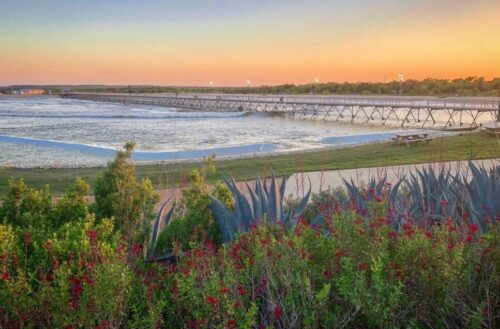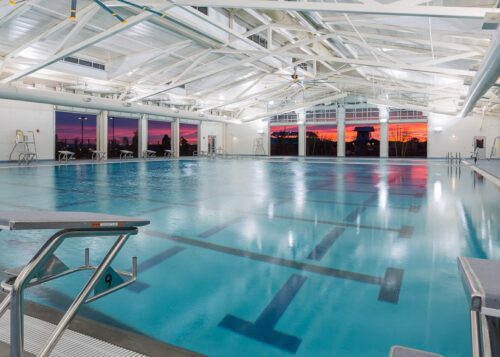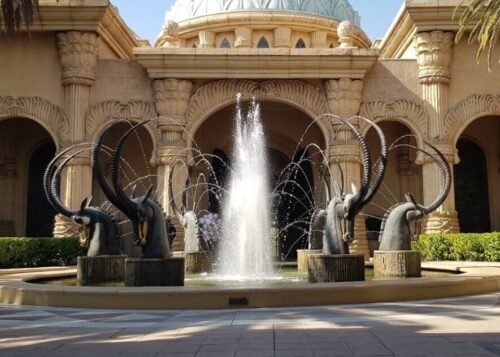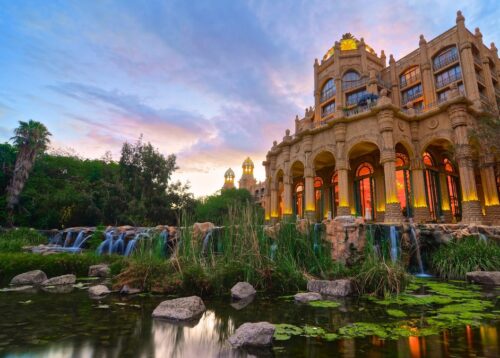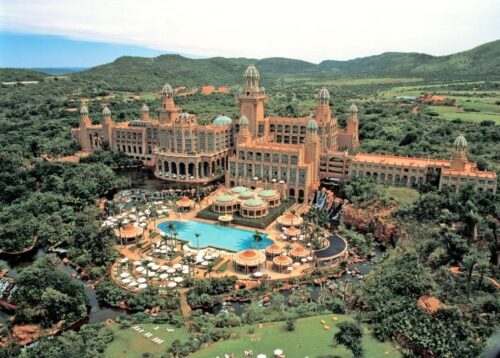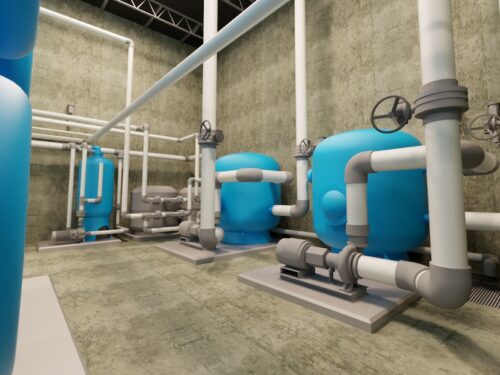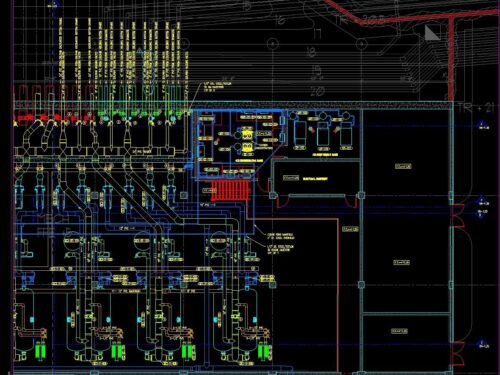Cloward H2O answers common questions on pool water disinfection - 8th April 2024
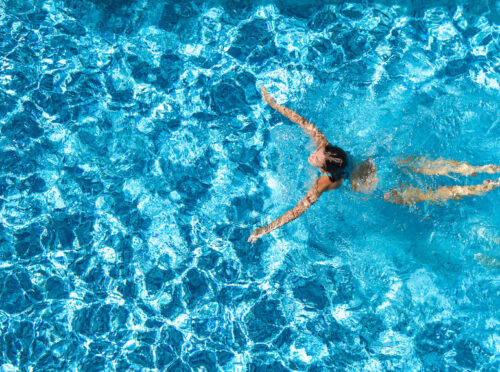
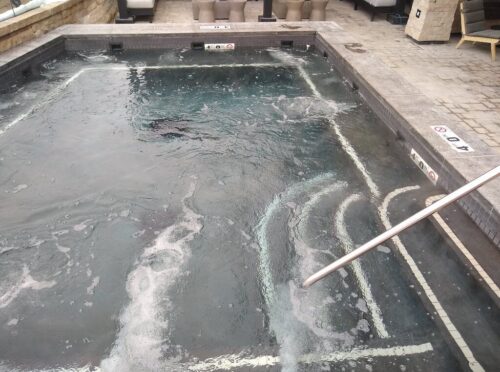
The firm’s shares insights into the issue of salt versus chlorine – a commonly asked question when dealing with pool water disinfection. Project manager Damon Roberts, a senior member of the firm’s team of experienced engineers and designers, discusses a few of the important variables.
Salt versus chlorine
Firstly, Roberts dispels the notion that saltwater pools are not chlorine-treated pools:
“The functioning principle behind a saltwater pool is to use dissolved salt to create chlorine directly in the water. Chlorine in the form of Hypochlorous acid is still the active sanitizer/oxidizer in both salt systems and traditional chlorine-dosed systems.
“The salt chlorine generator uses electrolytic cells to create chlorine gas (as well as oxygen and hydrogen gas) directly in the water. Dr. Alison Osinski summarizes salt chlorine generation this way, “Electrolytic cells, or more properly called ‘chlorine generators’, change non-iodized salt … into chlorine gas. Electricity is applied to salt dissolved in water to form hypochlorous acid (the active sanitizing ingredient in chlorine), sodium hypochlorite (liquid chlorine made from chlorine gas and sodium hydroxide), and hydrogen gas.”
Chlorine has been the standard method for treating pools since the early 1900s. However, the methods for introducing chlorine to the water have evolved over this time period. Chlorine gas was first recognized as a disinfectant for swimming pools in the United States in 1948. This is the purest form of chlorine, but also the most hazardous. Because of the material’s inherent risks, very few facilities today use chlorine gas systems.
Sodium hypochlorite (NaOCl) in a diluted solution, also known as liquid chlorine, is one of the most common forms of chlorine used today, including in cleansers, wipes, household bleach, and drinking water treatment.
“A concentration of 10-12% is typically used in swimming pool applications (bleach is normally about 5%),” says Roberts. “Hypochlorous acid (HOCl-free chlorine) is formed when chlorine dissolves in water and is a good sanitizer and oxidizer. With a few notable exceptions, this form of chlorine is highly effective against microorganisms in water.
Erosion-feed chlorine uses tablets or granules that slowly dissolve in the water to release chlorine into a pool system.
“There are two common chemical forms of solid chlorine: Calcium Hypochlorite (Cal-Hypo) and Trichloroisocyanuric Acid (Trichlor). Depending upon the tablet’s manufacturer, the composition varies slightly but is in the range of 65-70% available chlorine by weight. The remaining percentage is composed of inert ingredients and soluble salts that hold the tablets/pellets together.”
What are the differences?
The primary idea in evaluating the difference between salt chlorine generation and traditional liquid or solid chlorine systems is that, regardless of the system, the pool water is being sanitized by chlorine, not salt, explains Roberts:
“The major difference is the delivery and methods of how chlorine is stored and introduced to the treatment system. Salt chlorine generation systems create on directly in the water on site with very little if any storage. Traditional chlorine systems require storage and transport of the liquid or tablets.”
A pool’s sanitation system (regardless of method) must have a means of dosing chlorine at a rate sufficient to keep up with changes in bather load.
“When a sudden change in bather load occurs, more chlorine must be supplied to match the increased demand. Salt chlorine generation systems can only supply new chlorine at a fixed maximum rate, depending on the size and power of the unit, and can easily be surpassed.
“Reputable manufacturers recommend that supplemental chlorine dosing (liquid chlorine) systems be provided in pools that expect to see large fluctuations in bather load. For this reason alone a salt chlorine system is not acceptable for most resort environments or for heavy use pools such as in water parks.”
Maintenance
Any system will require some level of maintenance:
“Traditional chlorine systems require regular topping off of tanks or feeders and verification of feed operation. Salt chlorine generators require maintenance of salinity levels in the water and regular cleaning of the electrolytic cell due to electrochemical reactions that occur in the cell causing deterioration and fouling of the plates. Eventually, the plates will need to be replaced as they deteriorate beyond the level of acceptable performance.”
Water, in general, will cause corrosion, and corrosion is accelerated when the salinity of the water increases. This causes galvanic corrosion potential and chloride attack on metals exposed to the water.
“Salt chlorine systems require salinity levels of 3,500 to 5,000 ppm for proper operation. Though only about 10% of the salinity of seawater, this is still a significant factor when compared with typical potable water in the United States, which is normally less than 100 ppm. Corrosion can affect any metal in contact with the water including handrails, light bezels, fasteners, pump shafts and heaters.”
Proper application is key
As with most equipment selection, proper application is the key to a successful system design, says Roberts. There are proper applications for both traditional and “salt” chlorine systems.
“Salt chlorine systems are extremely effective for residential and lightly used commercial applications. For most commercial applications it is our opinion that traditional liquid or tablet chlorine systems are the best option.”
In applications where the owner is looking for options to reduce chlorine use, Cloward H2O recommends the use of secondary disinfection systems, such as ozone.
“Ozone is a powerful oxidizer that does most of the sanitization and oxidation work in pool water, reducing the amount of chlorine required. Salt chlorine generator manufacturers also recognize the benefits of secondary disinfection and may offer these systems as part of their packages.”
Cloward H2O shares insights into what makes a successful water treatment system - 6th March 2024
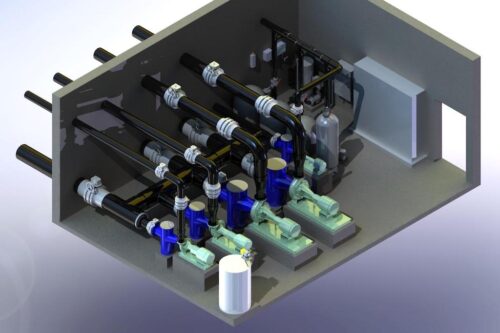
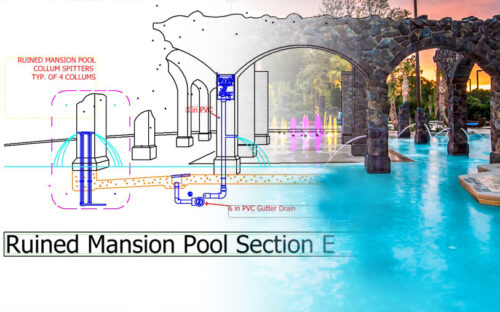
The firm’s approach to water treatment systems can be summarized into four main components: circulation, filtration, chemical treatment, and temperature control. With each of these components, various factors affect both OpEx and CapEx costs. However, the ultimate result is to provide recreational water that is clean, clear, and inviting for the guests and is easy and cost-effective to operate.
Circulation
The first element is circulation, and turnover rate is one of the critical factors. This is the time required to circulate the volume of water through the treatment system fully.
“Pools with large bather loads, high water temperatures, or small children require higher turnover rates than other uses. In our case, we typically recommend 30-minute turnover rates for hot tubs, spa pools and splash pads, 2–3-hour turnover rates for family pools, 4-5 hours for adult and beach pools, and 6-8 hours for residential plunge pools,” says the company. Turnover rates determine filter sizes and power requirements for circulation pumps.
The power needed for the feature pumps and circulation accounts for a large percentage of the electrical load of a water feature. Efficiency is aided by careful selection and pump sizing to match the needed performance closely.
“We recommend premium efficiency pump motors, which have 6-12% better energy usage than standard motors. Common industry practice is to provide a certain amount of over-capacity to accommodate differences between design and constructed conditions. This leads to conditions where a pump needs to be restricted using a valve to achieve the correct operating flow and pressure.
“Using a Variable Frequency Drive (VFD) is an excellent alternative method for tuning pump operation and optimizing pump efficiency. A VFD is an electronic device that allows the operator to have automated control of a motor’s speed. Reducing the speed of the motor, whenever full speed is not required, reduces power consumption and power cost.
“We typically specify Schedule 40 PVC for the majority of the underground pipe runs. For deep excavations as well as exposed pipe in the mechanical room we specify Schedule 80 PVC. Our design standard for pipe flow velocities is nominally 5-5.5 feet per second (fps) for pressure piping, 3 fps for suction lines, and 2 fps for gravity flow pipes. We utilize balance tanks, also referred to as collector or surge tanks, for all pools with gutters or infinity edges.”
In the construction document phase, the Cloward team analyses head loss for all water features piping networks to verify and adapt pump motor sizes. The piping networks will provide proper circulation within the feature to eliminate dead spots and provide circulation throughout the entire volume.
Filtration
Design, engineering, and operation of water-themed projects require filtration. Filters clear water and eliminate pathogen-harboring detritus. High-rate sand filters dominate aquatics filtration. They are inexpensive since they are the industry standard for filtration. Backwashing the sand bed by backflowing water through the filter removes debris and waste but uses a lot of water.
“An alternative to sand filters has emerged over the past ten years, which has several significant advantages to traditional sand filters, explains the company. “Regenerative media filters require far less water compared to sand filters. This is due to both extended filter cycles and minimal water volume required for backwash. The typical backwash cycle for a sand filter is twice a week, whereas regenerative media filters require backwashing typically once a month.”
Sand filters are backwashed at 20 gpm per square foot for up to five minutes per filter vessel, while regenerative media filters backwash volume is the filter tank volume times two. This reduces annual backwashing water loss by over 95% compared to sand filtration.
Other benefits of regenerative media filters include:
- Smaller particle size filtration. Regenerative media can capture particles as small as three microns. This is small enough to capture some waterborne illness pathogens, such as Cryptosporidium.
- Less water loss translates to lower chemical usage for sanitation since treated water is conserved, which reduces the need to treat new water.
- Less water loss also reduces heating costs since the need to heat incoming new water is reduced.
- Lower pressure drops across the filter than sand filters, accounting for about 14% savings in required pumping power.
- Smaller mechanical space requirements. It is common to save up to 20% of mechanical space over a sand filter-based system.
The downside to regenerative media filters is the higher initial cost of the filter compared to sand filters. The costs have been coming down but are still higher than sand filters. The typical return on investment (ROI) is anywhere from 18 months to three years.
“Cartridge filters are also a common filtration method and are mostly used for small systems,” adds Cloward. “Each filter type, whether it be sand, regenerative media, cartridge, etc., has its place in the aquatics industry. When deciding on a filter type, it is important to weigh the various options with their respective pro’s and con’s for each application.”
Chemical treatment
Chemical treatment systems comprise four main components: a primary disinfection system, a secondary disinfection system, a pH control system, and a chemical controller.
These technologies offer a way to eliminate or render the bacteria responsible for waterborne infections inactive. Chlorine is the disinfectant most often used in the aquatic industry. Oxidation Reduction Potential (ORP) regulates the amount of chlorine added to water to maintain the right residuals. In addition, bather contamination, temperature changes, ambient pollutants, and pH can all affect the disinfection process.
Primary disinfection system
This device delivers chlorine to the treatment stream at a suitable rate. Chlorine, the primary disinfectant, comes in liquid or pill form. A chemical feed pump takes from a chemical storage tank in a liquid chlorine system. Tablets are usually held in a feeder tank and dissolved in water before the chlorinated water is released into the treatment stream.
“Our first preference is to use liquid chlorine; however, the tablet form has its place as well. This decision needs to be guided by the availability of each form and the ability to move the product to the pool equipment rooms. During design, we request some guidance from the operations team as to their preference on the type of chlorine system that should be specified.”
When it comes to salt chlorine generators, the firm adds: “There is a lot of misunderstanding and misinformation regarding this technology. It is critical to understand that this technology still delivers chlorine to the water. Chlorine is provided as a component of salt (Sodium Chloride). Using an electrolysis process the sodium and chlorine atoms are split and the chlorine is used in the disinfection process, while the sodium remains in the water.
“We do not believe that salt chlorine generators are effective in commercial pool applications. We have seen the technology used in residential applications, where there is not a large bather load. We do not recommend the use of salt chlorine generators.”
Secondary disinfection system
More potent disinfectants are needed to tackle chlorine-resistant bacteria like Cryptosporidium in the aquatic industry. The 2014 Model Aquatic Health Code from the CDC includes secondary disinfection systems. Two secondary disinfection methods are approved: UV and Ozone.
Cloward H2O recommends ozone on almost every project due to its use as a powerful oxidizer with an ORP of 2.07 compared to chlorine, which is 1.49. Ozone is produced by a process known as Corona Discharge:
“Oxygen is exposed to a high voltage current that forces the oxygen molecule (O2) to form ozone (O3) molecules. Water flows through an injector assembly that mixes the ozone and the water in a very turbulent condition. The water is then moved to a contacting vessel where the ozone reacts with the organic compounds and organisms in the water. Ozone rips organic compounds and organisms apart. Ozone also reacts with chloramines reducing them back into usable chlorine compounds.”
These reactions happen very quickly, and the ozone is usually spent within a couple of minutes of introduction to the water.
“We base our recommendation on the ability to oxidize organic material and provide a higher degree of water quality, which will result in a reduction in the amount of chlorine usage. We have analyzed ozone in many projects as a better product than UV at controlling chloramines, which are responsible for swimmer discomfort and damage to pool facilities.”
Despite disinfecting the most water, ozone does not leave a residue; hence, it is considered a secondary method. Properly applied ozone reduces chlorine and acid by 60% compared to non-ozone treatment.
pH control system
In addition to ensuring that disinfectants work as effectively as possible and safeguarding the metal mechanical components and cementitious pool surfaces, proper pH levels also promote bather comfort. Usually, muriatic acid, also known as hydrochloric acid, is used to lower the pH of water. Usually, a chemical storage tank and a chemical feed pump are used to do this. The chemical controller regulates the acid dosage.
Chemical controller
In addition to a processing unit that decodes the signals from the probes, the chemical controller comprises pH and ORP sensors. Next, based on the ORP value or pH reading, the processing unit will signal the appropriate chemical feeder to administer acid or chlorine. Additional sophisticated features that compute additional factors for preserving the proper chemical balance in the water vary depending on the chemical controller type.
Temperature control
Usually, pools and hot tubs will be heated in the winter, and then they can be cooled in the summer, depending on the local climate.
“Because there can be a use for both heating and chilling of the water, we generally recommend, use of a heat exchanger. Although gas and electric heaters are very common in our designs as well. A heat exchanger effectively utilizes the water source at whatever temperature it might be pumped into the mechanical system.
“Designing and setting the water body at the correct temperature is critical to bather comfort. Guests can almost always tell if the pool is even 1 degree too cold.”
Cloward H2O concludes:
“Clean and safe water is the end goal of aquatic engineering. Proper water treatment happens through correctly applied engineering principles for filtration, circulation, oxidation, and sanitation. We use state-of-the-art technologies, industry best practices, and customized solutions to ensure crystal-clear water on every project.”
Cloward H2O dives into its design approach for very large lagoons - 12th January 2024
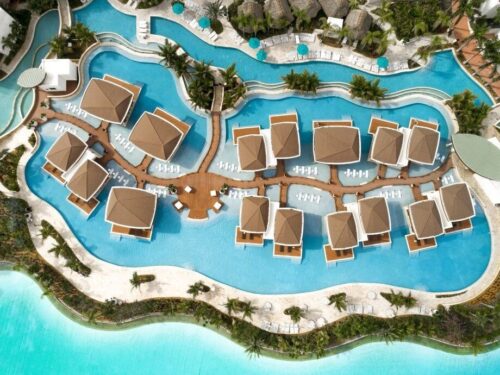
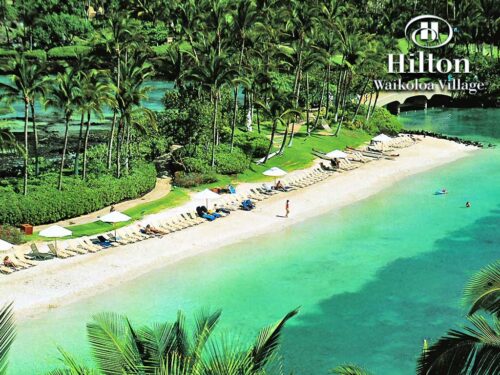
Cloward H2O has been designing lagoons since its inception in 1985. One of its first major projects was a saltwater lagoon at Hilton Waikoloa Village, which opened in 1988.
Earlier this month, Cloward H2O discussed the key water quality management considerations for very large lagoons. Now, diving deeper into the topic, Damon Roberts, project manager at Cloward H2O, has explored design approaches for such projects.
“Effective water treatment, indeed, systematic hygiene of any kind, relies on the implementation of multiple methods and barriers to contamination,” comments Roberts. “As technology and understanding improve, these methods increase both the ability of engineers to design effective systems and the capacity of operators to run them efficiently.”
Tailored approach
There are numerous water treatment methods and products available, and these technologies need to be assessed for their applicability in each specific very large lagoon application.
Although many approaches can be deployed, the primary design approach usually follows well-established parameters in the disciplines of water treatment and standards.
“At the outset of a project involving a very large lagoon, it is important to assemble a few key team members. Depending upon the type of development, many of these roles can be filled by professionals who are already providing services,” says Roberts.
The team might include an architect; landscape architect; aquatic engineer; mechanical, electrical, and plumbing engineer, site civil engineer; and specialists such as a geotechnical engineer, structural engineer, wave generator manufacturer, whitewater rafting course engineer, interior design architect, kitchen consultant, or audio-visual specialist.
The owner may also wish to hire construction or project management experts. However, in many situations, these services can be provided by the architect or engineering company that is already on the team.
When the project team is in place, they can assess the site conditions and available resources.
“Understanding the regulations from the local jurisdictions is a key part of this evaluation
process,” explains Roberts. “Once the team has completed their evaluations, they report their findings and recommendations and then work together to develop a site master plan, taking into consideration the operational characteristics of the project.”
Specialized services
The project can then progress to the engineering and planning stage, Cloward H2O advises. In this phase, different project team disciplines create construction documentation. Each discipline coordinates its specialized services, producing documents used to determine construction budgets and plans for the contractor.
A typical scope for this stage, from the viewpoint of the aquatic engineer, might include:
- Lagoon site layout, including lagoon grading, elevations, sections and detail annotations, liner restrictions and protection, and more.
- Lagoon site piping, including inlet returns and surface skimmers, drain sites, piping network routing to and from the filtration equipment room, and details and annotations.
- Cross-sections of the lagoon identifying the various edge conditions.
- The design and engineering of circulation and filtration system components, including the determination of turnover flow rates and the sizing of water treatment components.
- Developing process and instrumentation diagrams (P&IDs) to indicate the equipment sizing, control, and instrumentation components for water treatment, as well as the process flow.
- Creating plans and sections illustrating the location of equipment and pipe routing in a mechanical room is essential for determining the accessibility and clearances required for equipment repair.
- Designing the shell and liner systems, including structural components, and detailing the installation of piping and equipment for various edge conditions.
- Designing electrical and control systems, including power diagrams and operation details. Power distribution for water treatment equipment covers circulation, filtration, system monitoring, data logging, ozone production monitoring, control, flow instrumentation, and more.
- Development of written technical specifications for all work within the specialism’s scope.
- Collaborating with the project group to create a comprehensive design package.
During implementation, the team serves as a watchdog, reviewing contractor submittals, responding to requests for information or clarification, and performing engineering coordination and minor design changes to accommodate the contractor’s means and methods, construction plan, or unexpected site conditions.
“Site observation visits are conducted on an as-needed basis at key points to review the installation for conformance, to coordinate with the contractor to resolve questions or concerns, to assist with the assessment of completion, to review materials and products data, and to generally assist however possible,” says Roberts.
At substantial completion, the team creates punch lists for the contractor to finish before handover. The team also assists with final system tuning and operator training on the installed equipment.
Roberts adds: “The evolving nature of very large lagoons provides an interesting set of challenges. From a design and engineering standpoint, the main challenge is to provide a circulation and treatment system that delivers a safe level of water quality and that can be operated efficiently and sustainably. An additional challenge lies in working with regulatory agencies concerning the best ways to meet public safety requirements.”
Customized engineering
Cloward H2O is renowned for its wide-ranging aquatic experience and its commitment to designing safe, clean, and clear water for everyone to enjoy.
As a full-service engineering firm specializing in aquatic attractions and recreational water projects, Cloward H2O’s mission is to bring industry-leading technology to the design and engineering of unique water features. The firm has contributed to some of the world’s leading resorts and aquatic attractions, providing customized engineering designs to meet each project’s unique requirements.
Cloward H2O specializes in creating unique water features by offering customized engineering designs that align with the client’s vision and objectives. Its critical approach involves assessing and incorporating client goals, constraints, project opportunities, cultural aspects, and productivity considerations.
The team includes experienced civil, structural, mechanical, and electrical engineers and designers. Each project is led by a dedicated principal and project manager, with a skilled and creative project team tailored to the specific needs of the project.
Cloward H2O reveals key water quality management considerations for very large lagoons - 5th January 2024
Cloward H2O, has extensive experience in the design of very large lagoons and has revealed the key water quality management considerations in such projects.
A “very large lagoon” is a broad term used to describe a specific class of recreational water bodies, typically exceeding one acre in surface area and one million gallons in volume. Their considerable size makes traditional swimming pool standards for water treatment economically impractical. Adherence to building and health department codes varies by project location and intended use, influencing applicable standards and regulations.
“There are at least two functions this category of water body can serve,” explains Damon Roberts, project manager at Cloward H2O. “First, the lagoon may be strictly ornamental, such as a lake system for a golf course. This type of very large lagoon does not typically require code compliance, however, the treatment systems used to maintain an ornamental lagoon also apply to other purposes.
“Second, a current trend in the industry is for the lagoon to be used for swimming or other water recreational activities, such as kayaking, canoeing, paddle boarding, or even jet skiing. A very large lagoon may serve as an artificial surfing lagoon or as a whitewater rafting course.”
Because there is a low ratio of bathers to water volume, applying traditional swimming pool design to very large lagoons is challenging. These lagoons should be treated as recreational water bodies, akin to natural lakes with live systems and natural water circulation. As natural lakes are often not found at project locations, the engineered solution of a very large lagoon becomes necessary.
Water quality management
Developing a water quality management programme is crucial for projects involving very large lagoons. Establishing performance characteristics and operational standards ensures safety, aesthetic appeal, and sustainable operation from the project’s outset.
Due to the undefined classification of very large lagoons in existing regulations, Cloward H2O says that collaboration with local authorities is essential. It is acknowledged that these lagoon systems align more closely with open recreational water standards, considering their size and patron usage, than with swimming pools.
“Very large lagoons hold many times the water volume of a standard recreational pool, with patron/surface water ratios much smaller than the typical loading in pool, which can be as low as 1:15 ft 2,” comments Roberts.
“The patron/water surface ratio for a waterpark is generally about 1:30 ft 2, compared to 1:1,200 ft 2 for whitewater rafting parks and 1:15,000 ft 2 in a surf park lagoon. However, a very large lagoon also resembles a pool, a fully constructed body of water with no natural flow through, and therefore pool requirements are also taken into consideration.”
Quality compliance
The water quality compliance criteria for very large lagoons include two main standards: the Secchi disk evaluation for water clarity, and EPA-established open recreation water standards, restricting faecal coliform count to 400 CFU per 100 ml.
Unlike pool sanitation standards that focus on residual chemical levels, the faecal coliform count in lagoons serves as an indicator of potential disease-causing organisms, emphasizing a different aspect of water quality assessment.
Roberts explains: “The control of pathogenic organisms in water is key to bather safety. Waterborne pathogens, such as Cryptosporidium, Pseudomonas, Giardia, Shigella, Escherichia coli, etc. have long been the major target of swimming pool treatment systems.
“In addition to these organisms, amoebiasis (amoebic infection) has been found to be a problem in open recreation waters. Organisms like Naegleria fowleri, colloquially known as the “brain eating amoeba,” have become a concern. Although pathogenic organisms occur naturally in bodies of water, the proper application of a water treatment system can reduce the likelihood of infection.”
Key considerations
The water quality management system for very large lagoons encompasses four essential components working synergistically for consistent clarity and microbial control. In addition, Cloward H2O advises that the lagoon’s water source should be carefully considered.
1. Circulation
The Circulation system in very large lagoons involves a water treatment pump, drain, and inlet piping. It ensures water movement, eliminating stagnation, facilitating surface water removal, and ensuring circulation spans the entire depth of the lagoon.
The use of circulation pumps with variable frequency drive (VFD) motors optimizes power efficiency and enhances operational flexibility in the lagoon system.
2. Filtration
Filtration is crucial in water quality management, mechanically removing contaminants to enhance clarity and reduce chemical demands. High-rate sand filters are commonly used in swimming pool applications.
“However, with the large water volumes of very large lagoons, sand filter technology often becomes cost-prohibitive in both capital and operational costs,” advises Roberts. “Sand filters are also not efficient for water conservation. Other filter technologies, such as regenerative media, permanent media, and rotating drum filters, are more suitable for application in very large lagoons.”
Filters for very large lagoons must remove 30+ μm particles for optimal water clarity. In addition, the periodic use of a flocculent like aluminium sulfate aids in aggregating small particles, enabling the use of larger micron-size-rated filters.
3. Sanitation & oxidation
Sanitation in very large lagoons involves reducing microorganism concentrations through oxidation reactions. Chlorine is partially used, but ozone application is a superior method for achieving effective sanitation.
Roberts explains: “Ozone is a powerful oxidizer that reacts quickly to destroy microorganisms like Cryptosporidium and Naegleria fowleri. Ozone does not maintain a residual presence; thus a minimal dosing of chlorine (0.5 to 1.0 ppm) is needed in the very large lagoon to satisfy sanitation requirements.”
4. Temperature controls
Controlling temperature is usually a small part of water quality management for large lagoons. Maintaining a specific temperature may not be practical, but negative impacts from water temperature can be mitigated by various measures depending on the lagoon’s climate. Typically, the water temperature in a large lagoon closely will remain within a few degrees of the average ambient air temperature.
Adaptable systems
Circulation design aims to achieve a flow rate that interrupts microbial life cycles and allows continuous chemical monitoring and dosing. It requires local adaptation to ensure effective mixing, filtration, and oxidation.
“Filtration technology employed must be effective in removing suspended particulate material and debris from the water. Clarity standards are achieved by ensuring that all water is circulated and that particles larger than the visual acuity threshold are removed,” says Roberts.
“Regardless of other parameters and operating conditions, the bottom of the water body should be clearly visible from above at all times. Depending upon conditions, the lagoon may need to be vacuumed to remove settled large debris and deposits of sand or dirt.”
Continuous operation of treatment systems, with the flexibility to adjust based on lagoon conditions, is vital. Dynamic monitoring and adjustment ensure efficiency, sustaining proper water quality, clarity, and sanitation, while integrated instrumentation and telemetry notify staff of incidents even in their absence.
Water source options
Achieving water quality, sustainability, and cost-effectiveness in large lagoons varies based on location and available water resources. Traditional potable water fill and sanitary discharge may not suit very large lagoons. However, a net-zero strategy to source, store, and maintain water resources on-site offers an ideal approach.
Seawater serves as an ideal source for large lagoons with open or partially open systems, featuring constant flow rates. Installations may utilize various intake structures, ranging from sea floor extraction to onshore wells. Depending on seawater quality, filtration and sanitation are necessary to prevent the entry of aquatic life, including soft corals, small fish, invertebrates, and shrimp.
“Seawater does present challenges and costs related to equipment selection and construction materials, but these issues are well understood. Additional challenges may include the design of the intake and outfall structures or wells and the provision of sufficient protection against wave action and accessibility to beaches,” Roberts adds.
Surface water use
Diverting or pumping surface water, including stormwater capture, is also a feasible water source option. The system design, open or partially open, depends on the available water’s quality and quantity, mirroring seawater source considerations.
“Where surface water quality is not sufficient or consistent, or where a large enough quantity of surface water is not available, a recirculation treatment system will be required,” explains Roberts. “The use of constructed wetlands, successfully employed in many large lake systems to filter and remove nutrients from surface water, applies to very large lagoons.”
Groundwater is a further water source option. Well water sources vary in quality, ranging from brackish to high mineral content or very good quality. Understanding the source allows a treatment system to be engineered for good water quality.
Potable water sources ensure good quality, however, Cloward H2O advises that this is often the costliest option operationally. Technologies are available to minimize water usage and optimize related operational costs.
In addition, the use of greywater in large lagoons holds potential, but it involves risks and regulatory considerations. Evaluation of the treatment plant’s reliability is crucial. Despite these concerns, reclaiming filter backwash water is valuable for an overall water balance plan.
Cloward H2O discusses secondary disinfection systems - 6th December 2023
Research on the methods of prevention and treatment of pathogens is well-established, with processes in use at facilities such as pools, drinking water treatment centers, sewage treatment, and industrial applications.
The Model Aquatic Health Code (MAHC) outlines the importance of secondary disinfection systems and recommends two technologies: ozone and UV.
Benefits of ozone
Ozone is the most effective oxidizer and sanitizer that is safe to use for both humans and aquatic life.
It is used within the aquarium industry and Aquatic Animal Life Support Systems (LSS), in conditions which are similar to those in commercial swimming pools and waterparks. The same principals of filtration and circulation apply to both kinds of applications.
However, LSS engineers are not able to fall back on chemical treatments which would harm the aquatic creatures, or close the pool. Instead, in these settings it is essential that engineers can rely on high-quality equipment, redundancy, high turnover rates, mechanical and biological filtration, ozone, and a vigilant husbandry team to monitor and maintain a healthy environment.
The aquarium industry uses ozone as its primary sanitizer and oxidizer. Ozone has the unique capacity to achieve high microbial kill rates within a treatment system while leaving no adverse residual effects in the exhibit waters and has supported the establishment of large aquarium facilities throughout the world.
Because of its significant oxidation properties, ozone also plays a vital role in reducing organic load levels. It improves water clarity by binding smaller contaminants into larger, filterable byproducts.
Whilst UV sterilizers are being used more widely in both commercial swimming pools and LSS, it does not provide the aquarium industry with the significant operational benefits that ozone offers. The capital costs for UV are lower than ozone, however, UV does not offer a saving over time. It is also not the most effective method of pool sanitation and is consistently outperformed by ozone in third-party validation testing.
Ozone offers many benefits to a sanitation system and should be used in combination with residual sanitizer, which ozone cannot supply because of its rapid reaction rate, and mechanical filtering.
Learning from LSS
LSS systems usually feature a turnover time that is significantly less than that of a swimming pool, and even less for smaller or more packed tanks. There is a significant organic load in these living spaces that needs to be taken into account, unlike in a swimming pool, which is meant to be a “sterile system. This follows the general rule that higher turnover rates result in cleaner water and reduce the chance that pathogens will be able to get past the pool’s defenses.
Biological filtration is another type of filtration used in LSS. In essence, bio-filtration is a microbial environment where beneficial bacteria are permitted to proliferate and consume weak and outnumbered pathogen organisms. All surfaces inside the system and tank become home to these helpful bacteria, as in a lake, stream, or the ocean, because there is no chemical residue to inhibit their growth.
“As we consider the design of a pool treatment system we must consider the lessons learned from the aquarium LSS. This may require the designer to increase design filtration rates beyond code requirements and above accepted minimums, utilizing filtration sized larger than is customary,” says the firm.
They recommend that in every project, particular attention should be given to secondary sanitation and oxidation treatment. Through their interaction with water monitoring systems, these secondary sanitation technologies will provide more precise control over water quality parameters. This provides the operator with the means to monitor and maintain excellent water quality with the least amount of intervention and work.
Cloward H2O is a member of the Model Aquatic Health Code Council and collaborates with other members to assure swimmer and animal safety. Cloward H2O has over 45 years of experience working with bacteria and virus disinfection technologies. Every aquatic project is part of its ‘water perfection’ umbrella, and training and advice are provided for management and operations teams.
Cloward H2O shares experiences as Aquatic Specialists for Sun City - 16th November 2023
The 5-star resort is one of the Cloward H2O’s oldest and most iconic clients and features a varied range of aquatic attractions. It opened over 30 years ago and is regarded as South Africa’s Las Vegas.
With over 40 years of experience in participating in the design and engineering of aquatic projects, Cloward H2O’s portfolio includes virtually every aspect of Aquatic Attractions. Projects have ranged from simple fountains to expansive man-made lakes and river systems, hotel pools to full-scale waterparks, and individual aquarium tanks to some of the biggest aquarium facilities on the planet.
Timeless facility
Sun City’s Water Theme Park contains one of the oldest surf and wave lagoons in the world, set with turquoise waters and sandy beaches. An 18-hole 100-hectare golf course incorporates 28,000 square meters of water features and is famous for the hazard on the 13th hole – Nile crocodiles.
One of the most popular tourist attractions in Sun City is The Palace of the Lost City, a resort and casino which features The Valley of Waves and Waterworld facilities.
The Valley of Waves is an extensive water theme park with amenities that include sandy beaches, lazy rivers, and thrilling waterslides.
Sun City’s Waterworld is a man-made lake spanning 1000m x 500m in a natural volcanic valley. This immersive environment allows families to wakeboard, jet ski, parasail, and enjoy a variety of other activities.
Cloward H2O was appointed as the Aquatic Specialists to design Sun City’s unique resort water amenities.
Corry Cloward, president and principal, explains: “Sun City incorporates a little bit of everything, from fountains and waterfalls, rivers, pools and spas, lakes, a waterpark and even a wave lagoon that can be used for surfing! Roaring Lagoon contains approximately eight million liters of water. When the pool is used for surfing it can generate an eight-second rideable wave, 40 times per hour.”
The massive wave pool, The Roaring Lagoon, generates a 1.2-meter-tall wave with a speed of 35 kilometers per hour every 90 seconds, which crashes onto the sandy beaches. In addition, The Sacred River is a 500-meter-long underground lazy river that carries two million liters of water. The Temple of Courage plummets the rider 17 meters down a 70-meter chute, under a bridge, and into a pool below.
The resort also features the Viper and Mamba tube slides, with a water capacity of 75,000 liters, and the children’s Adventure Mountain area, which includes one mini body slide, five mini speed slides and a splash pool with a water capacity of 35,000 liters of water.
“Throughout our years in business, we have had the pleasure of forming many lasting friendships and wonderful partnerships with the people and firms that we have worked with all over the world,” says Cloward. “We have learned that providing excellent services and quality material always pays off in the long run.
“Looking back at how well some of our most iconic projects have endured through time demonstrates this lesson. Sun City is still in operation today over 30 years since opening!
Cloward H2O is proud to have been a part of this timeless and groundbreaking facility.”
Cloward H2O explores the importance of choosing the right filtration technology - 12th October 2023
Cloward H2O shares insights into why filtration is a critical component of any successful water themed project, and how the type of filter technology used can have a significant impact on elements of a water feature including water quality/clarity, operational costs, and guest experience.
When it comes to aquatic features in the attractions industry, the two most suitable choices are sand filters and regenerative media (RM) filters. Cloward H2O outlines the differences, to help operators determine what type is better suited to their project.
High-rate sand filters
When comparing initial capital expenses alone, sand filters are probably the most cost-effective alternative over RM filters because they are the industry standard. However, the expense does not include just the cost of the filters. It is necessary to consider the following factors: the amount of mechanical space; the number of filters and the corresponding amount of piping and labour required for their installation; the cost of filter media; the expense of wastewater treatment and make-up; the piping systems for each filter; and the electrical requirements.
In terms of their capabilities:
- Particles as small as 15 microns can be eliminated by sand filters. Particles smaller than 15 microns have the ability to affect the chemistry and purity of water. Therefore, it is essential to pay closer attention to the water chemistry of a pool while employing sand filters.
- Sand media must be changed around every 5-7 years.
- Sand filters use lots of water. Backwashing filters every 3-5 days is typical. Pool water is reversed through the sand medium to discharge filtered particles at 20 gpm/sf during a backwash. A single filter backwash lasts for approximately 5 minutes and all that water is sent to waste.
- The typical layout of sand filter tanks in a pool mechanical room is horizontal. Tank vessels can be stacked on top of one another to reduce the amount of floor space needed, however, this normally requires at least 20 feet of unobstructed space.
- Sand filters require higher pumping power to operate when compared to RM filters.
Regenerative media filters
The alternative filtration option, RM filters, offers a number of noteworthy benefits in comparison to conventional sand filters. When comparing costs and making a decision between these two distinct forms of filter technologies, there are numerous other aspects to take into account. On its own, an RM filter system will initially cost more than an identical sand filter system.
Here are some of the key points:
- Particles as fine as one micron will be eliminated using regenerative media. This is sufficiently small to contain microorganisms that cause water-borne illnesses, such as Cryptosporidium. Water clarity can be significantly increased and balanced water chemistry can be easier to maintain when particles as small as one micron are removed.
- RM filters require far less water to run than sand filters. Backwashing an RM filter is usually necessary once every 15 to 20 days. When an RM filter backwashes, the tank is emptied twice, resulting in a total water waste of two tank volumes. According to reports, RM filters can function with up to 95% less water than an equivalent sand filter.
- Less water loss equates to less chemical use for sanitation because treated water is preserved and less needs to be treated. As there is less need to heat fresh makeup water, less water loss also translates to less heating expenses.
- Less pumping power is needed to run RM filters. About 14% less pumping power is needed since there are lower pressure drops across the filter than with sand filters.
- The amount of mechanical space needed can often be reduced by 20%–30% or more when compared to sand filter-based systems. Additionally, this can reduce the cost of running the necessary HVAC systems.
Compared to sand, the yearly running costs of regenerative media are substantially lower. Because they run at a lower pressure, they consume less water, sewer, and power. They also waste significantly less acid and chlorine because they flush out less chemically treated water into the sewer. RM filters usually produce a break-even ROI after 1-3 years of operation when comparing initial capital expenses between RM and sand filters.
“At Cloward H2O, we are well versed in many different filtration technologies and their pros and cons,” says the firm.
“Part of our aquatic engineering process is selecting the appropriate filter for each aquatic attraction on a project and helping the client understand the ramifications of each selection. At the end of the day, the aim is to provide aesthetically pleasing water that will enhance the guest experience while protecting the health of those who interact with the water.”
Montgomery Whitewater: creating a new outdoor lifestyle destination - 11th September 2023
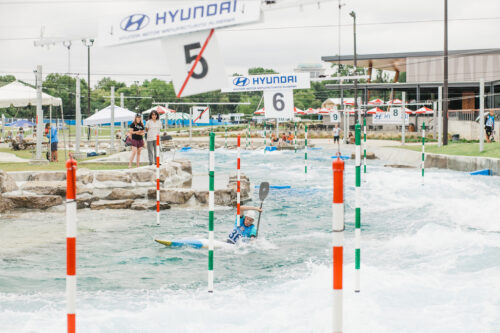
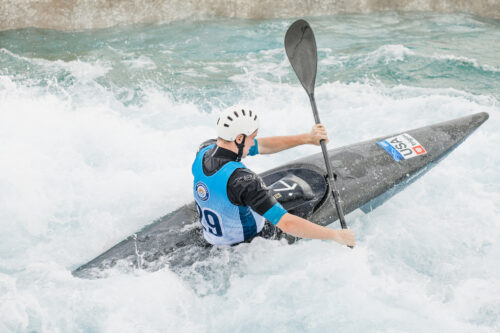
On 8 July 2023, a major new outdoor lifestyle centre opened in Montgomery, Alabama. A project several years in the making, Montgomery Whitewater is now bringing whitewater and other water sports thrills to the city, in a drive to promote economic growth, improve residents’ quality of life, support ongoing tourism development, and increase Montgomery’s appeal to a wider workforce – one that places a premium on quality of life when choosing a place to live and work.
The centrepiece of the development is an Olympic-standard, recirculating whitewater course. This will offer beginner to expert-level challenges to people of all ages and ability levels. A Class II whitewater experience is delivered along a 2,200-foot Adventure Channel that mimics a natural river, acting as a great introduction to the activity. Meanwhile, the 1,600-foot-long Competition Channel is an excellent playground for those with more experience.
The course also has training sections appropriate for commercial operations and a standing wave surf element.
The next development phase will see the addition of dry-side outdoor pursuits like hiking and bike trails, climbing walls, ziplines, and ropes courses. Montgomery Whitewater can host festivals, competitions, and weekly events. It is also home to hospitality features such as a conference centre, cabanas, and other meeting areas. Camps, team-building activities, and first responder training for swift water rescue are all possible at the venue.
This transformational project was the result of many expert teams working together to make the initial vision a reality, from leaders in design and architecture to skilled specialists in water engineering and filtration. To find out more about the process of bringing Montgomery Whitewater to life, and to learn about what it means for the region, blooloop speaks to some of the industry leaders that made it happen, including Cloward H2O, S2O Design, Liquid Design and Motus Management.
Getting the teams together
Montgomery Whitewater was initially the brainchild of Megan McKenzie. A Montgomery local, she wanted to put her city on the map.
McKenzie’s vision was for Montgomery to have a place where people could play, somewhere that would bring in people from out-of-town and make the city a more exciting place to live. McKenzie’s sister paid a visit to the new U.S National Whitewater Center in Charlotte, North Carolina, and the idea for Montgomery to have a whitewater centre of its own was born.
Following some early meetings with city officials, she was advised to gather the best team of experts that she could, in order to bring this idea to life. So, she assembled a team of designers, engineers and managers, with both the experience and the know-how to work on such an ambitious project.
Jeffrey Gustin of Motus Management, the owners’ rep/project manager for Montgomery Whitewater, explains:
“Like many project types, the success of the project comes down to the quality of its team. Montgomery Whitewater was led by S2O Design, the worldwide leader in manmade recirculating whitewater parks. Accompanying, and of equal professional expertise, were both Liquid Design and Cloward H2O. They provided key architectural and water engineering expertise, gained through multiple similar project executions.”
Designing the experience
S2O Design and Engineering was the lead designer for the Montgomery Whitewater project. The firm was responsible for the design and layout of the channel.
Scott Shipley, founder and president of S2O Design and Engineering, is no stranger to the world of watersports. He competed in three Olympic games and has four world titles under his belt as a slalom canoeist. His firm also designed the U.S. National Whitewater Centre and the London Olympic Whitewater Park.
“The great thing about this project was that it was the culmination of the lessons learned on all these other projects that we’ve worked on,” says Shipley. “Having that strong team that could rely on was a huge part of that of that process.
“Montgomery Whitewater is something that we’re super proud of. It was about an eight-year process to get this project from inception to construction. So, it’s the culmination of a lot of effort and work.”
The benefits of Montgomery Whitewater
Talking about the benefits that the new centre will bring to the region, Shipley adds:
“The nice thing about Montgomery Whitewater is its location. This is a project that was created to serve as a catalyst for the brand, and especially the tourist brand, of the city of Montgomery. On the one hand, we’ve created a whitewater park that is a place of fun and recreation. But it’s also serving to redevelop a part of town that needed redeveloping and to revitalise a tourist industry that needed revitalisation.”
“In addition, this facility brings a lot in terms of functionality and excellence to the United States watersports programme. This is our newest and most advanced whitewater channel. It’s also in place now, roughly five years before the USA-hosted Olympics in 2028. It’s a great place for athletes to come and prepare for those games.”
However, the location also presented the teams with a challenge, explains Shipley.
“This is a site that was cobbled together in the middle of a city. And so, as we gathered the land parcels, some from the US government, some from private ownership, some from the city, one of the bigger challenges was to create a design that functioned on the land we already had, but also anticipated the land we thought we would get. That allowed us to be efficient with our timing.
“One of our bigger challenges was fitting onto that postage stamp that we had, but then making that seamless as we went into land construction with a whole site.”
Creating a space that caters to all
For the project architect, Liquid Design, the key challenge was transforming this parcel of land into a space that served a lot of different user groups and varying occupancy counts, from weekday activities to large weekend festivals and competitions. This meant that the firm needed to design spaces that were flexible and multi-functional. The spaces also needed to be efficient for the staff to operate for any given user experience.
“Montgomery is the latest generation of man-made whitewater,” says Michael Williams, co-owner and president at Liquid Design. “S2O Design & Engineering creates very efficient and powerful moments in the water for the boater to experience. They are masters at shaping the water to create a certain user experience while rafting or whitewater kayaking. But none of this would have happened without Cloward H2O’s engineering experience and understanding of how to move the water, super clean water at that, from point A to Z.
“While the engineers were working their engineering magic, Liquid Design was busy creating architecture that supports a sense of place through the built environment. We focus on these unique project types not only to support the active participant but also to be a place to come and experience, as an observer, a place for community to foster and grow.
“They are unique places to hang out, enjoy food & beverages, people watch, and most importantly entice you to try an active outdoor activity. To achieve this, we start early with the placement of the various buildings and how they are incorporated into the masterplan. Especially with key whitewater features along the channel system. Working with the entire design team, we identify ways to maximize the user experience both passively and actively.”
A social experience
Liquid Design’s top four main architectural design features on the Montgomery Whitewater project are the large canopy system at the main entrance, the restaurant patio placement, the beer garden, and the trip talk pavilions.
“We designed a unique canopy system, with large timbers for columns. This creates a shaded space that connects the two main buildings for the project,” says Mimi Williams, senior project architect at Liquid Design.
“This canopy acts as the living room for the project. It will be a popular spot during the hot summer months. The placement of the restaurant patio was very important to us as well. We worked with the engineering team to have some of the most exciting whitewater located in this area. This maximizes the visual experience while enjoying food & beverages with friends. It’s a unique experience where the active and passive environments come together.
“It’s an experience that you can’t get anywhere else.”
Clear water for Montgomery Whitewater
As Michael Williams says, Cloward H2O’s engineering and filtration experience is key to the guest experience.
Cloward H2O provided engineering services for the pump station, upper and lower basins, river channel structural and waterproofing. It also worked on whitewater flow circulation pumping, water quality management systems, and control and automation systems. Finally, the firm provided as several speciality items such as conveyor systems, slalom gates, and obstacles within the course.
Corry Cloward, president at Cloward H2O, says:
“Clear water starts with the mechanical system. You’ve got to have great filtration and effective circulation. It’s got to be the right filtration for the specific application so that we remove all the particulates from the water. The water chemistry, turnover time and circulation of the water must be correct to keep the entire water body clean through all conditions.
“With any project our team does, we make sure it is designed correctly for the specific needs of the client. Cloward H2O has been in business for nearly 50 years with over 1000 successfully completed projects around the world. Water Perfected is what we’re all about, in terms of water quality certainly, but also in regard to all aquatic-related engineering.
“In this, the Montgomery project is no different than any other we engage in. Go to Montgomery and look at the water, it is crystal clear, and it looks awesome.”
Conserving water
One of the key challenges for Braden Steiner, project manager with Cloward H2O, and his team, was trying to figure out a way to conserve water:
“We knew we were working with a large body of water. So, we needed a solution that would filter it and it clean and flowing, without losing too much water. That meant we needed to figure out a layout that would work with the landscape, and that would be conducive to keeping the water as clean as possible without wasting it.
“We worked with landscaping to help them understand grading-wise how to keep runoff from coming into the pond and washing dirt and pollutants into the pond itself. Plus, we worked with the civil engineering team to help them understand how to drain all that runoff away. Then on our end, it was about recapturing dirty water and cleaning it and putting it back into the pond.”
The Cloward team knew from previous projects that one of the biggest water losses is in backwashing. Particularly when there is such a large amount of water to clean.
“So, we implemented a backwash recovery system that takes all that water and cleans it, losing only around 5% of that total backwash volume. That’s a major reclamation.”
If this backwash recovery system was not in place, Montgomery Whitewater would lose about 14,640,000 gallons of water every year due to filter backwash. In comparison, with the backwash recovery system in place, the venue will only lose about 480,000 gallons of water every year to backwash. The holding tank is also used as a fill system for makeup water recovery due to evaporation and other losses. This system reduces water loss by around 95%.
Reliable filtration for Montgomery Whitewater
The filtration solution put in place by Cloward H2O uses 24 high-rate horizontal media filters. The use of Activated Filter Media (AFM) instead of sand allows filtration to get down to around one micron of ozone, and chlorine at 18,000 gpm total treatment flow.
“The AFM allows us to get to a finer micron and get some of those smaller particles out, improving clarity,” explains Steiner.
In addition:
“The system requires a large mechanical room with a lot going on. So, we also integrated an intuitive automated monitoring system, to help the process go smoothly for the maintenance staff.”
With so many people using the facility, the reliability of the system is key.
“There’s redundancy everywhere. The system is designed to handle the heaviest, worst-case load. But we found that running under normal conditions, they can almost run at 50% and maintain the water quality. Then when they do get a severe load, they can ramp it up and handle it quickly. So that was one thing that they were happy about. They have a lot of extra capacity to do what they need to do.”
Allen Clawson, principal at Cloward H2O, adds:
“Montgomery Whitewater highlights the skills of our team in many aspects. This is a 4th generation design for our team. It’s a complex project with many unique constraints and requirements, but not outside of our experience. The massive size of the aquatic elements, the volume of water involved, the many complex structural elements, mechanical systems, power delivery, and controls all required considerable expertise to get the engineering right.
“Our approach with any project and client is to use sound engineering principles to make it work. Whatever you have, we will figure it out and that’s exactly what we did.”
Highlights of an eight-year project
Any project that is as complex as this one is bound to have challenges. Especially when a global pandemic happens in the middle of construction.
“Projects like this are unique in nature,” says Gustin. “Many of the key elements are critical to its success, including patron safety, regulatory controls, and water quality. As the project is led by industry professionals that have addressed, most if not all, engineering issues during design, the most challenging aspects of the project arise during construction, specifically addressing new material applications and processes.”
“Through close coordination with the design team, the construction team was able to work through these issues and maintain a two-year project schedule without missing the targeted opening.”
There were also highlights along the way. For Steiner, one key moment was when the team knew that what they had set out to achieve on paper had worked in reality:
“A definite highlight was turning the system on. We were then able to see how the number crunching had resulted in this system that worked the way it was designed to. In the end, the filtration system outperformed what we expected it to do.
“These are my favourite types of projects, these large, unique projects. It’s fun to be one of the key players in such an iconic destination. That’s what gets me excited. It’s going to bring a lot of real value to the area and attract more people to the area too. We’re excited to see where that goes.”
Montgomery Whitewater opens to the public
The other project team members also agree that seeing Montgomery Whitewater open to the public, and seeing it being used and enjoyed, is the biggest highlight:
“I love seeing the facility in operation and watching people come on-site for the first time. It always seems to generate a smile of delight & surprise,” says Mimi Williams.
Michael Williams adds:
“Early in the design process, I encouraged the architectural design team to focus on creating a design solution that focused on building up a community by creating spaces that brought the participants together.
“Whenever you achieve something together, such as rafting down class III / class IV whitewater, you create a “friendship bond” with others who have experienced it with you. And that’s where the food & beverage comes in. Sitting around together reliving the experience, telling stories, and planning the next trip, that’s what forms community. After seeing the venue in full operation, I’m convinced that the designed environment can foster that goal. Now it’s up to the citizens to develop that inclusive community.”
A popular new destination for Montgomery
The centre held a grand opening in July. Since then, it has been met with nothing but high praise from both locals in Montgomery County and visitors alike.
“While the project is in its initial operating stages, phase two elements are already being planned. This includes additional land sports, retail, a distillery, and a 120-key hotel,” says Gustin. “The highlights of this project, initially named the “catalyst”, are doing just that by proving that public money for the whitewater project, is providing a central hub for the project will spur private development to Montgomery County expanding its quality-of-life goals.”
“People across the board love the whitewater park,” adds Shipley. “It’s been a real success. It’s also achieved its stated purpose, which was to encourage development in that part of town. The biggest highlight was the grand opening. That’s when we were able to roll this thing out and show people what had been created for them, for their community. That was fantastic.”
Southern Whitewater Development Group is the developer and operator of Montgomery Whitewater. The project was made possible by state, local, and community leaders who formed the Montgomery County Community Cooperative District. This partnership was led by The Montgomery County Commission, the City of Montgomery, and the State of Alabama.
Cloward H2O celebrates opening of ULUM Resort at Looking Glass Rock, Utah - 25th August 2023
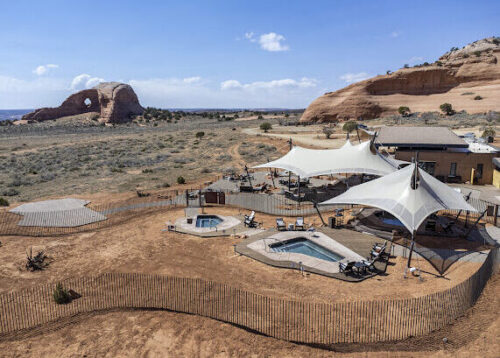

Cloward H2O, is reflecting on the work done for the recently opened ULUM Resort by UnderCanvas at Looking Glass Rock near Moab, Utah, US. For this project, the firm provided full-service aquatic engineering and design for the three dipping pools provided by ULUM as an amenity to guests staying at the resort.
This new luxury glamping resort offers guests travelling and vacationing in the picturesque area of Moab a one-of-a-kind experience. While offering luxury, it also welcomes families with children and dogs. Each tent has a wood stove, an evaporative cooler, a private deck, electricity and furniture, and the central gathering space is home to a fine-dining restaurant.
In addition, the resort provides yoga lessons with a view of the stunning red rock landscape. ULUM Moab offers luxurious lodgings in a remote desert location with views of Canyonlands National Park, surrounded by stunning scenery, and only a short distance from Looking Glass Arch.
The three dipping pools that the Cloward H2O team worked on offer an extra relaxing amenity for guests, and can either be chilled or heated. They each include an individual water treatment system that is built to handle the significant sediment load that is anticipated in the water, from both the wind and people using the pools. Each of the three pools also includes an ozone system to further improve the water treatment and quality.
The concrete of the pools was planned and constructed in accordance with ACI 350, and it was made to endure the extremes in temperature that the Moab region faces over the course of a year. Wheelchair access is also available to one of the pools.
Guest feedback has been positive, with visitors saying that the dipping pools offer a relaxing sanctuary to escape at the end of the day.
“One great thing about Cloward H2O is that we design everything in the recreational aquatics sphere from the big to the small and anything in between,” says Bradley Clawson, project manager at Cloward H2O. “This may be a smaller project, but it is impactful in its space because it was the first time UnderCanvas included dipping pools as an amenity on any of their properties. And it’s not every day you get to design pools with that kind of view!”
Cloward H2O brings state-of-the-art water treatment to new Montgomery Whitewater centre - 6th July 2023
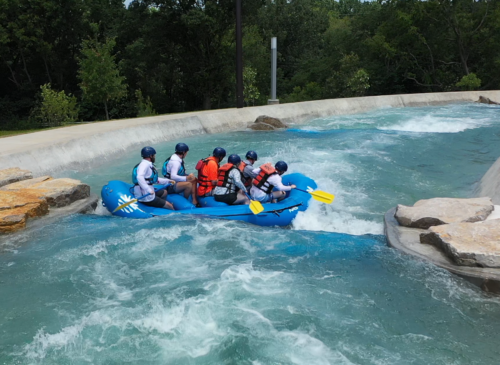

Cloward H2O provided a mechanical solution to the very large amount of water needed for the park that uses 24 high-rate horizontal media filters. The use of Activated Filter Media (AFM) instead of sand allows filtration to get down to around one micron, Ozone, and chlorine at 18,000 gpm total treatment flow. “When the mass flow pumps are off, we are able to see the bottom of the main pond which is 25’ down! In comparison, the Alabama River adjacent to the part, you would be lucky to see 25″ down,” says Phillip Melton, operations manager at Montgomery Whitewater.
When needed, each of the 24 horizontal media filters in the backwash recovery system backwash into a large holding tank adjacent to the mechanical pumping room. This holding tank has its own separate filtration and ozone system that is recirculated. This allows for significant savings when it comes to wastewater going to the sewer.
If this backwash recovery system was not in place, Montgomery Whitewater would lose about 14,640,000 gallons of water every year due to filter backwash. In comparison, with the backwash recovery system in place, the venue will only lose about 480,000 gallons of water every year to backwash. The holding tank is also used as a fill system for makeup water recovery due to evaporation and other losses. This system reduces water loss by around 95%.
With the ability to accurately control the environment, man-made whitewater courses like these will revolutionize Olympic and similar competitions, allowing visitors to have a safe and controlled experience. The channels can be easily adjusted in order to provide varying types of rapids and levels, catering to everyone from beginners to seasoned experts. Each rafting experience is 90 minutes long, which typically ends up being four to five times around the whitewater channel.
Guests will be able to build their skills without having to travel to remote places and buy expensive equipment. Centres like these can be built close to large urban areas, allowing greater and more convenient access to more people.
“Montgomery Whitewater isn’t just for extreme adventurers and high-intensity kayakers,” says Allen Clawson, principal at Cloward H2O. “Most of the people that will come to Montgomery are those that have never even been down a rapid’s river before or just a few times in their lifetime.
“The difference with Montgomery and other whitewater centers coming out in this new emerging recreational space is that people can come back the next day and a few times a month. It’s much easier to get good at the sport, you don’t have to drive five hours to spend all day on the river catching only a few rapids. Whitewater parks and the growing surf parks industry are allowing people to return visit and get good at something a lot faster.”
“Cloward H2O worked alongside a great team of professionals that brought this project together as a team, a project this scale can face some interesting and difficult challenges let alone that fact it was coming about during Covid,” says Braden Steiner, project manager for Montgomery Whitewater at Cloward H2O.
“We are grateful to have clients and partners that go to bat for us and we do the same. Everyone has a part to play in these great projects coming to life and it’s always great to see one get completed.”
Cloward H2O worked alongside Southern Whitewater Development Group (SWDG), Jesco Inc. Construction, S2O Engineering, Liquid Design, and GMC to bring Montgomery Whitewater to life. This transformative venue will enhance the quality of place for the River Region, driving economic development and boosting tourism.
Future plans for the site include the addition of rock climbing, mountain biking and ropes courses, as well as access to the Alabama River for kayaking and standup paddle boarding. An on-site hotel and retail units will also be added.
Cloward H2O prepares for opening of new world-class whitewater centre in Montgomery - 14th June 2023
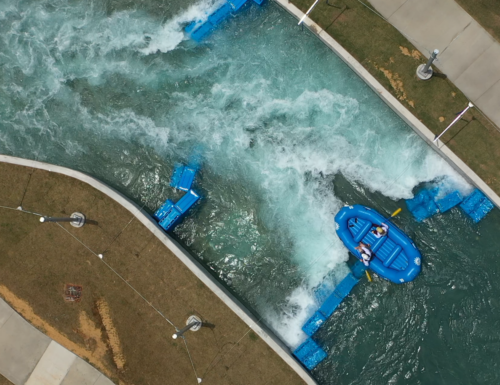

Cloward H2O has been working on a major project in Alabama for several years and is now ready to celebrate the opening of Montgomery Whitewater, a new outdoor lifestyle centre, set to open its doors on 8 July 2023.
A recirculating whitewater course, built to Olympic standards, will serve as the development’s focal point and enable users of all ages and skill levels to engage in challenges ranging from beginner to expert. The course also includes a standing wave surf feature, and training areas suitable for all abilities and commercial operations.
Additionally, the park will have a range of dry-side outdoor activities like climbing walls, ziplines, ropes courses, and hiking and biking routes. Numerous festivals, tournaments, and weekly activities will be held at the site. There will also be hospitality amenities, including a conference centre, cabanas, and other gathering spaces. The facility will be available for camps and team-building events, as well as swift water rescue training for first responders.
The new centre will promote economic growth, significantly improve residents’ quality of life, support ongoing tourism growth, support military missions, and increase Montgomery’s appeal to a talented workforce that places a premium on quality of life when choosing a place to live and work.
Participants can receive world-class whitewater instruction in a setting ideal for everyone from novices to experienced rafters. A 2,200-foot-long Adventure Channel that mimics a natural river is designed to deliver a Class II whitewater experience and serves as a great introduction to the activity.
Meanwhile. the 1,600-foot-long Competition Channel is an excellent playground for those with more advanced talents and is perfect for the novice rafter wishing to take on greater rapids. Both channels intersect in the lower pond to the takeout or back up the conveyor belt for another run!
Initial conversations began in 2016 with preliminary designs and a professional team formulating in 2018. Cloward H2O and other design team members finalised detailed engineering in 2020 and construction documents in 2021. This was followed by two years of construction to bring Montgomery to what it is now.
“On these big projects a major challenge is just working through the scope of the whole facility,” says Braden Steiner, project manager for Montgomery Whitewater at Cloward H2O. “This is not your typical pool; we’re talking 12,000,000 gallons of very active water, there are so many things to account for.
“There is a great team of professionals on this project figuring out how it all works, and we are honored to work with them.”
Allen Clawson, principal and managing partner at Cloward H2O, adds: “Another major challenge was Covid -19 like many projects around the world development stopped for a while, construction costs increased, including material costs and delays, labor shortages, it threw some curve balls at the team, and we are proud of the project getting to this point. It’s been a long time coming and we’re excited for it to get to the opening date!”
The park recently held a soft opening for the first few people to test out the river rapids, and it was a big success. The facility is well on its way to being ready for 8 July with personnel training, facility tuning, ongoing testing, and some final touches.
Innovations like RapidBlocks technology were implemented into Montgomery in over 80% of the channel, allowing unlimited tuning of flow and rapid configurations to create variations to the constructed hard wall configurations set by the concrete. Specially engineered operable gates and diversion structures allow the operator to adjust the flow characteristics of key features or operate either channel independently.
Cloward H2O designed the mechanical and filtration systems with high-rate horizontal media filters, AFM, ozone, and chlorine at 18,000 gpm total flow. In addition, five Flight Submersible Propeller pumps, 700 Hp each, 82,300 gpm at 25’ TDH for a total of over 400,000 gpm, were implemented to provide enough waterpower down the channels to create the big rapids for the centre. The total connected power comes out to over ~4 MW at 4160 VAC.
A total of more than 16,000 cubic yards of concrete was poured and shaped to form the ponds, channel system, conveyor bay, and pump station. In order to keep waste to a minimum, Cloward H2O and the design team were able to use a unique partial siphon system that reduced the operational power of the Mass Flow Pumps once a steady state flow is established.
Cloward H2O Reflects on successful Kuwait Scientific Center project - 24th May 2023
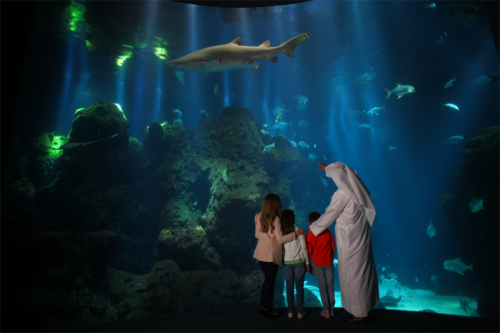
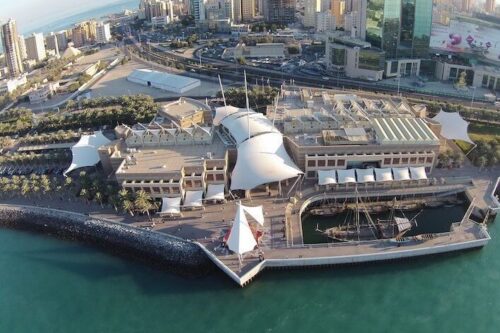
Cloward H2O prepared design and construction documents for the indoor aquarium facility at the Kuwait Scientific Center, for both freshwater and salt-water. The attraction was completed in 1999, and the firm’s responsibilities included the design of all tanks, pools, and aquatic life support systems for the entire aquarium facility.
The centre, which was the biggest aquarium in the Middle East at the time of construction, was designed to provide environmental education, as well as reflecting Islamic arts and culture. The walls of the building contain depictions of stories that tell visitors about the city’s history.
The Scientific Center covers 80,000 square meters and is home to more than 100 different species. It also houses historic Dhow boats docked in an old-style harbor outside the aquarium. Highlights within the sail-shaped building include giant spider crabs, fluorescent jellyfish and floor-to-ceiling shark and ray tanks.
In the first habitat, a desert ecosystem, visitors can view owls, snakes, scorpions, kangaroo mice, beetles, and bats. Animals like the boa and otter, as well as shallow-water fish and South African penguins, can be found in the second habitat, the coastal zone. Tropical fish, jellyfish, seahorses, sharks, stingrays, and sea turtles can all be found in the third environment.
In addition, more than 50 interactive displays at Discovery Place engage learners of all ages, advancing environmental, scientific, and technological awareness. Discovery Place offers simple and fun ways to create and learn about magnetic, solar, and kinetic energies.
Guests aged 14 and over with an open-water scuba diving license can also enjoy the Dive with the Sharks program. There is also an IMAX theatre, showing 45-minute educational videos about the natural world.
Cloward H2O Shares Insights on how to Make Pools & Water Parks More Environmentally Friendly - 20th Apr 2023

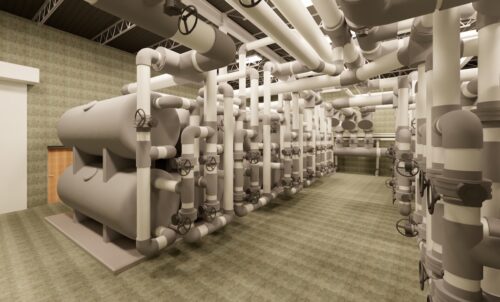
There are more than 300,000 existing commercial and recreational pools in the US aquatics industry alone, with thousands more being constructed every year. As the number of pools grows, environmental impact and saving money steadily become a greater concern.
For an existing facility, maintenance is essential.
Maintaining proper pool chemistry should be the number one priority of every pool operator. Pool chemistry has a strong effect on air quality, and if the air quality is bad, particularly in an indoor facility, it can have a negative impact on the building structure and HVAC system.
Allen Clawson, Principal and Managing Partner at Cloward H2O says: “Operators should consider: is the treatment equipment in good repair? Is the paint coming off the walls? Is there scaling or etching on the pool shell because the water chemistry is out of balance? If the pool is enclosed, are the roof or walls falling apart? Are the pool area and back of house areas clean? These are all signs that something is wrong and can have a negative effect on pool patrons causing them to go somewhere else.”
When parts of the facility finally fail and need to be replaced, this creates a strain both environmentally and economically. The facility will need to close while the repairs are carried out and the deteriorated equipment, structure, or surface material will need to be removed and disposed of. More resources, energy and manpower will be required to generate the new products and have them installed. All the while this is costing the facility money with no steady income stream.
How can a pool facility reduce its use of natural resources? Running a facility like this uses a tremendous amount of energy. A pool needs electricity (pumps, controllers, motors, and other equipment) and fuel (often natural gas or propane for heaters and boilers).
“Some facilities use more energy than they need to, simply because the equipment was sized incorrectly,” says Allen. “Besides using the right size of equipment, using high-efficiency motors and heaters/boilers, VFDs (Variable Frequency Drive) on systems that have varying loads (such as fans on the HVAC system), selecting low emission heaters and boilers, and using solar heating and natural lighting to its full advantage will make a huge difference both ecologically and financially for the facility.
“Other ways to reduce the amount of energy include using pipe sizes that require less head from the pump, turning down the treatment system at night when no one is in the pool, implementing a heat recovery system that works to the advantage of both the pool treatment system and the HVAC system, and heating the makeup water.”
Every facility is unique, and these potential savings should be carefully considered and thought out.
Water is the whole reason that aquatic facilities even exist. Clean potable water is not always readily available in all parts of the world, and can be costly to generate or transport, sometimes well over $10 per 1000 gallons. The average cost of potable water in the US is about $2 per 1000 gallons. Thus, the makeup water of a 100,000-gallon pool will cost between $6 and $30 for the water alone every time the filters are backwashed, and this does not consider evaporation and splash-out.
“Regular backwashing is critical for filter operation and maintenance and to ensure the long life of the filter and filter media, reduce the power required by the pumps, and maintain good water quality. However, there are options worth exploring, including emerging filter technologies, that can reduce the strain on the local freshwater supply.”
For example, the Beijing Aquatic Center, built for the 2008 Olympics, has a system that collects the rainwater from the roof into a cistern to use as needed for makeup water.
“On the other end of the water equation is the actual water that is disposed of during backwash. This water is the vehicle that takes the dirt from the filters away from the facility. One suggestion is to recover the backwash water, filter and treat it, and then reintroduce it back into the pool as is done with large aquariums.”
“This typically is not suited for pools because it may violate health department regulations. Backwashing also helps control the level of TDS by maintaining proper dilution levels. But backwash water can still be put to good use; it can be run through a drum screen and used for greywater irrigation instead of using culinary water.”
There may be some concern with the chemical content in the backwash water. There are many places that will not allow backwash water to be dumped into the sanitary sewer because of the pool chemicals. This concern is raised primarily because of the risk of any oxidizers (i.e. chlorine) destroying the microorganisms required for the treatment of wastewater.
Except for a few cases, most backwash water has a low ORP level. If this does become an issue and concern, the addition of sodium thiosulfate will resolve this. If the backwash water is used for greywater irrigation, moderate levels of chlorine are not a concern since most culinary water systems already have a chlorine residual and have been successfully used for the watering of plants, trees and grasses.
There are alternatives to using chlorine as the primary sanitiser, which are cheaper and environmentally friendly.
Allen says: “One such alternative is the use of ozone working in tandem with chlorine or bromine. Ozone has received a bad reputation from health departments and pool operator courses. While it is true that ozone can be dangerous if not dealt with correctly, a well-designed system will eliminate the risk of any harmful effects from ozone.
“Ozone is generated on-site as needed from ambient air, so there are fewer chemicals that need to be transported and stored, and no hazardous byproducts are created. You will still need to have chlorine in the pool as a residual sanitiser to meet health department requirements, but the amount of chlorine required is greatly reduced. This means that less chlorine needs to be produced, transported, and stored.”
Because of the savings in chemicals, an ozone system can usually pay for itself in two years or less. And as a bonus, water quality will be better.
Implementing and operating a “green” aquatic facility is not as overwhelming as it may sound.
Being environmentally conscious does not need to come at the expense of the patron’s experience or reduce a facility’s bottom line. In fact, an environmentally conscious facility will generally improve the patrons’ experience and also save the facility money.
“It is always easier to make a facility green starting from the design before it is even constructed, but even facilities that have been around for decades can improve operations that will have a tremendous positive impact. Proper maintenance, higher efficiency pumps, reducing chemical use and improving air quality are all items that should be addressed by every facility.
“Products and technology in the aquatic industry are continuously advancing. When items are due to be replaced, serious thought and consideration should be given to using high-efficiency and environmentally conscious products.
“At the end of the day, everyone benefits from a green facility.”
Cloward H2O brings water play to Beaches Turk & Caicos resort - 16th Mar 2023
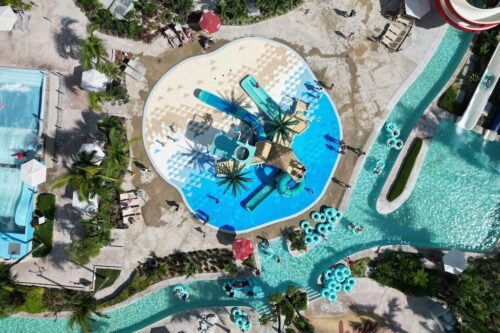
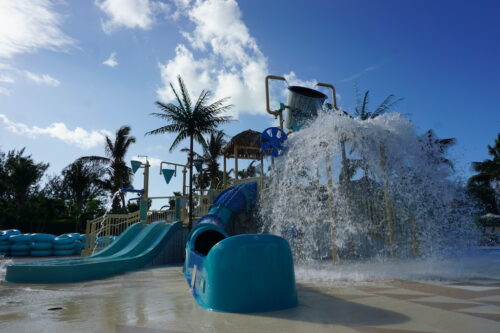
Cloward H2O was responsible for designing and implementing a water feature project at Beaches Turk & Caicos resort, an all-inclusive family resort in the Caribbean. As part of the destination’s 45,000-square-foot waterpark, the firm was asked to design a small yet enjoyable water feature project.
The Traveler’s Choice Awards, presented by TripAdvisor, recently recognized the Beaches Turks and Caicos resort as having the world’s best beach. Introducing an exciting play structure next to it adds another draw for the destination.
Mohanad Abbood, an engineer, and project manager at Cloward H2O, led the Beaches Turk & Caicos Play Structure project as his first project.
Although the project seemed simple, there were certain problems that had to be solved. The team redesigned a section of the current waterpark, in cooperation with EDSA and BCQS International Construction, and needed to place new machinery and pipelines in a limited amount of space due to their constrained timeframe and available space.
To create fun children’s slides and other activities for a play structure in the centre of the resort, Abbood and his team were able to come up with a solution. Almost 1500 GPM of treated water flow rate was necessary for the project. The small space, which was bordered by a slow-moving river, piping, and concrete work, was the first challenge. The second was to create a filtration system with mechanical parts that would fit in the available space and continue to keep the existing features running.
In order to stay within the set constraints, the team successfully came up with a design that incorporated a new filtration system while making use of already-existing machinery to save money and time. Abbood was pleased with the project’s completion because it allowed the children to have more fun with the water feature.
“The project was an excellent opportunity for Mohanad to showcase his leadership skills and deliver noticeable engineering and planning work,” says a statement from the company. “Cloward H2O’s success was the result of effective collaboration, communication, and teamwork which enabled them to execute and complete projects on time and within budget.”
Cloward H2O shares insights into water feature control systems - 7th Mar 2023


Cloward H2O, wants to give some key information for those looking to choose the right water feature control system for their latest project. All aquatic systems need some type of control to automate portions of the system, like water level, temperature, filter operation, and water chemistry, but there are many different options and levels of complexity. Control systems can range from simple equipment interlocks to pre-packaged control systems, or full custom controls.
Firstly, stand-alone pools or water features that don’t require a lot of automation are best suited for the simple interlock control technique. This is sometimes referred to as “relay logic”, and does not call for any computerized or programmable logic controllers (PLCs).
“This approach ensures that various elements of the system cannot operate without the primary systems functioning by utilizing auxiliary contacts on the treatment pump or other equipment to power or enable those functions,” explains Rob Cloward, project manager and senior engineer at Cloward H2O.
Simple interlock control strategies are fairly inexpensive and easy to install, as well as being simple to troubleshoot and maintain. On the other hand, they are limited in capability and are not ideal for more complex functions, like implementing functional changes to the system, data log operation records, or sending alert notifications to operators in the event of a fault condition.
There are several packaged control systems available off the shelf that are appropriate for running aquatic systems. Onboard controllers for a particular piece of equipment that may connect to and control other common components are a common example of packaged controls. This particular controller is frequently seen in conjunction with specific Filter Control Panels and Chemical Controllers.
“In addition to controlling the filter or chemical feed, these controllers often have the ability to control treatment pumps, booster or feature pumps, water temperature, etc.,” says Rob Cloward. “Some can also be configured to send text/email/phone alerts to operators in the event of a system fault.
“The challenge with these on-board, pre-packaged units is that they too are limited in functionality and may only successfully control a portion of the overall system, especially if that system has multiple complexities. These limitations can sometimes be overcome by creating a hybrid control system using both onboard controls and simple interlocks. The customer and technical support of these systems is often very good.”
Some commercially available control systems are more of an add-on given by the manufacturer intended to easily connect to and control their equipment with the potential to additionally interface with other system components. These off-the-shelf controls can be highly configurable. They can store operational history for troubleshooting purposes and they may also be remotely accessed by a smartphone, tablet, or another device. They can provide automated operator alerts, and come with excellent customer and technical support.
Custom controls (pictured, top) can be configured to do just about anything, monitoring and controlling an unlimited number of pumps, filters, valves, heaters, lights, blowers, and many other types of equipment, based on parameters like pressure, flow, temperature or time. These systems can retain operator and service records, give operator alerts, enable remote connection, suggest remedial action and maintenance, and record operational data. The options are, essentially, limitless.
However, Rob Cloward adds:
“These systems can also be very expensive. Depending on the features, level of control, and functionality, the costs for these systems can range from several thousands of dollars to several hundred thousands of dollars. These systems are also only as good as the person or company that builds, installs, and programs the system. When done correctly, custom control systems can be a tremendous operations asset – reducing operation errors, identifying, and correcting potential issues before they become problems, and helping to optimize system parameters.”
Large aquatic facilities with numerous pools and features are frequently the greatest candidates for custom controls.
“The best control fit for your aquatic project depends on the types and numbers of aquatic features, and what you want the system to do,” says Rob Cloward. “Understanding what options are available along with operating expectations can help determine the best path forward.
“While a good control system can be a valuable asset to your project and facility, the control system can never replace good operators. A well-designed and constructed aquatic system, connected to an appropriate control system, operated by knowledgeable and competent operators is a recipe for success.”
Cloward H2O celebrates long-standing Atlantis aquatic resort projects - 6th Feb 2023
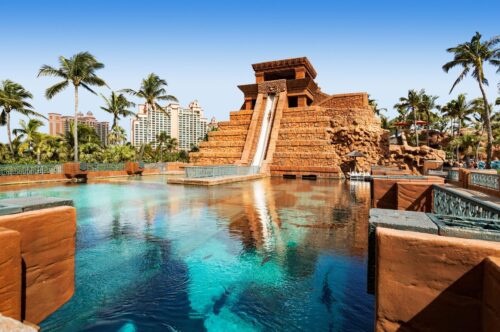

Cloward H2O, is revisiting two major premium resort projects in the Caribbean and Dubai as they celebrate over 25 years of success since Atlantis made its debut in The Bahamas. The company is using the opportunity of a new season to look back at how well some of its most iconic projects have endured through time:
“For more than four decades, Cloward H2O has been privileged to participate in the design and engineering of thousands of aquatic projects spanning virtually every aspect of aquatic attractions,” says a representative of the design company.
“These projects range from the simplest of fountains to large manmade lakes and river systems, hotel amenity pools to full-scale waterparks, and individual aquarium tanks to some of the largest aquarium facilities in the world.
Atlantis Paradise Island
The venue is home to an array of aquatic activities designed to compete with the top water park amenities in the world within a beautifully landscaped and themed environment, setting a new benchmark for quality and innovation.
Cloward H2O collaborated with DTJ Design as the site designer and ProSlide Technology to develop Baha Bay, a $200 million beachfront luxury themed waterpark in the Bahamas that combines relaxation and excitement.
Despite the schedule constraints, this 15-acre park in Nassau opened in July 2021, with Cloward H2O developing and engineering the pools and aquatic systems for all of the park’s water attractions, including aquatic structural, mechanical, and electrical design.
A river system runs through the park, as well as a 500,000-gallon wave pool, and a state-of-the-art FlowCurl surf simulator from WhiteWater, alongside rafting and body slides.
Turtle Beach and Stingray Cove are two kid-friendly zones with small pools, twisty slides, a multi-level play structure with a tipping bucket, and a battle zone built for fun and excitement. Baha Bay features 11 custom-designed slide complexes from ProSlide’s cutting-edge Best Rides collection.
Cloward H2O collaborated closely with the project design team to ensure that each pool had the greatest possible qualities, including crystal clear water, high-end finishes, and low-maintenance operation. The consumption of power and water was a key consideration.
The end result saw the project being named the Caribbean’s Leading Water Park 2022 in the World Travel Awards, and receiving the Gold Nugget Merit Award for Best International Resort/Hotel.
“Developing a park like this on an island challenges the engineering team to use resources as efficiently as possible.” says Allen Clawson principal and managing partner at Cloward H2O. “Our team was able to implement best practices and technologies resulting in significant water use reduction, lower power consumption, and savings on chemical use when compared with typical waterparks.”
When Atlantis Paradise Island first opened its doors in phase one in 1994, it set a new benchmark for hotels and outdoor facilities in the resort hospitality sector. With each successive development, it continued to raise the bar.
Phase Two included numerous swimming pools and slides, including the landmark Leap of Faith, as well as aquarium attractions containing 50,000 animals in a fully immersive ancient Atlantean habitat. This slide, the first of its type in the world, drops riders more than 60 feet from the top of a Mayan Pyramid into clear plastic slide portions that blast them through the shark tank.
Aquaventure, a one-of-a-kind, 141-acre waterscape with additional pools, a downhill action river with rapids, tidal surges, and various other effects, and Dolphin Cay, an 11-acre interactive dolphin lagoon that includes swimming coves and sandy beaches, pools, an education centre, an animal rescue rehabilitation hospital, and other animal care facilities, was added in Phase Three to complete the offering.
Atlantis became the first mega-resort of its kind at its opening, and even more than 25 years later, continues to set high standards for premium resorts across the world.
“The sheer size and complexity of a 141-acre water park designed and engineered by Cloward H2O on hotel grounds turned these impossible dreams into reality. Pioneering new types of aquatic attractions on a scale such as this resulted in what is still considered the top vacation destinations in the world,” adds the firm.
A key objective of the resort is to help maintain the Bahamas’ unique ecosystem for future generations of visitors, something in which Atlantis remains a key stakeholder.
The Atlantis Blue Project Foundation is a nonprofit organization that has worked since 2007 to protect species and their habitats throughout the Bahamas and the Caribbean Sea, funded and supported by Atlantis Resort.
Atlantis guests can participate in interactive learning opportunities and special encounters with animals in their secure enclosures while helping to develop sanctuaries for various species.
Atlantis The Palm
Atlantis The Palm is located in Dubai on the artificial Palm Island. The resort launched in 2008 and quickly became the largest aquarium and largest waterpark in the middle east, replicating in one go what took three phases and 15 years to create in the Bahamas. With its latest expansion, Atlantis’s Aquaventure Waterpark has become the largest waterpark in the world.
Atlantis boasts a variety of resort dining establishments, luxury retailers, a lively nightclub, spa and fitness centre, as well as a large number of meeting and event rooms which remain in high demand thanks to its impressive location atop The Palm Jumeirah crescent.
The vision of bringing Atlantis’ ancient civilization to the UAE was successfully transformed by Cloward H2O and the resort’s design team into a distinctive water playground with one-of-a-kind attractions.
Its famous 27.5-meter Leap of Faith drops riders through a clear acrylic tunnel submerged in a lagoon filled with sharks, whilst Shark Attack spins riders in tubes through darkness before emerging into another acrylic tunnel suspended in a real shark tank.
There are also three Master Blaster slides and a 2.3 km Rapids loop which allows riders to traverse river sections of high-intensity whitewater rapids and waterfalls interspersed with calmer sections, opening up to large zero-entry pools with roomy sundecks.
The main draw of the resort is its aquatic activities, including both freshwater and marine attractions. Aquaventure features over 18 million litres of water across its 17 hectares. More than 65,000 fish and other sea life representing more than 250 species live in the 42 million litres of salt water that are present throughout the entire resort.
The primary attraction, Ambassador Lagoon, is designed to resemble the streets and boulevards of the fabled lost city of Atlantis. The habitat includes marine species from the Arabian Gulf and the adjacent area’s local waterways.
Seawater is taken from the Arabian Gulf into an open-flow system through a nearly four million-liter reservoir. Before entering the marine habitats surrounding the resort, the water is filtered through sand, treated with ozone, and sanitized.
This aquatic ecosystem closely resembles the conditions that marine species would encounter in the wild, with continual environmental change and seasonal temperature variations. A fish hospital with isolation pools for babies, sick, and acclimating marine creatures will also be part of the marine ecosystem.
“Throughout our years in business, we have had the pleasure of forming many lasting friendships and wonderful partnerships with the people and firms that we have worked with all over the world. We have learned that providing excellent services and quality material always pays off in the long run,” says Corry Cloward, president and managing partner at Cloward H2O.
Cloward H2O Returns for Second Boca Resort Project - 23rd Jan 2023
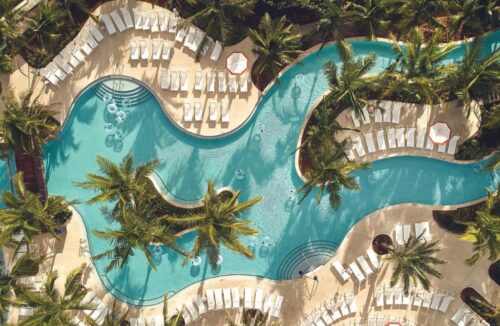
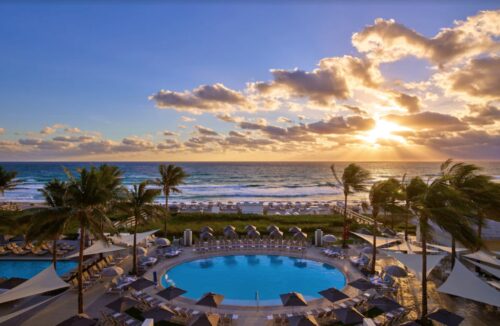
The Boca resort was initially conceived in the 1920s by renowned Florida architect Addison Mizner, and it debuted in 1926. The resort, which was first known as the Ritz Carlton Cloister Inn, swiftly attained a five-star classification. The resort now spans more than 200 lake and seaside acres with five different hotels after adding more rooms, restaurants, and gardens throughout the following century.
The first time Cloward H2O was involved with the renowned resort operator was in 2005 when the Boca Beach Club underwent refurbishment and had water elements added to complement the stunning surroundings. Cloward H2O finished the design for four new luxurious and relaxing seaside pools and different fountains in 2007, working with EDSA and Garcia Stromberg.
The same client called Cloward H2O again in 2019 to restore a different area of the site, the Boca Raton Resort & Club. Nearly a century after its first debut, the $200 million resort in southeast Florida opened earlier this year, ushering in a new era for the company.
Together with EDSA, Garcia Stormberg, and Weller Pools, Cloward H2O designed a spectacular retreat for the contemporary traveler. Outdated features of the resort have been removed or improved, and new features have been added including four pools (one for adults only), a splash park, a 450-foot lazy river and two water slides.
A FlowRider surf simulator is also now available, allowing guests to sample the surfing experience without touching the shoreline.
Cloward H2O assisted with structural and waterproofing engineering for pool sections, mechanical and control system design, electricals for water play and spray features, water flow, and pipe network engineering.
The company were also consulted for water treatment design, water chemistry control, pipe layouts and electrical engineering for the equipment room and pools, including lighting selection.
“We are proud that Boca Beach has lasted over fifteen years,” says the president of Cloward H2O, Corry Cloward. “Cloward H2O aims for quality engineering design on every project out the door. This is enhanced by the many projects that last numbers of years across the world and in this case the old project brought forth the new.”
“Boca Beach was a redevelopment project aimed at creating a new space that would bring a new level of relaxation to the iconic resort. More than fifteen years later we are proud to do it again to Boca Raton Resort & Club with the same client.”
Cloward H2O’s Baha Bay Water Park project wins awards - 19th Dec 2022
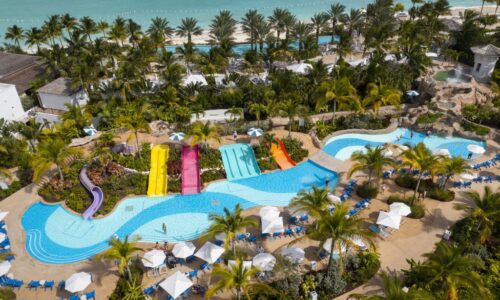
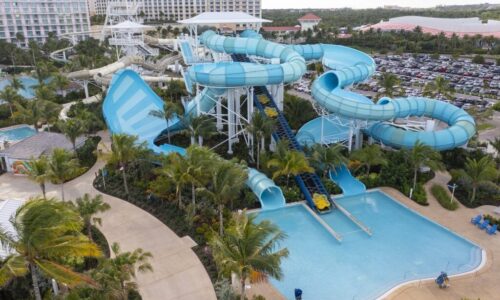
Cloward H2O is celebrating the completion of a successful award-winning project in The Bahamas.
Baha Bay Water Park was meticulously designed to provide everything from a romantic encounter for couples seeking isolated lounge spaces to a world-class adrenaline experience for youths and a fun adventure for families.
The venue is home to an array of aquatic activities designed to compete with the top water park amenities in the world within a beautifully landscaped and themed environment, setting a new benchmark for quality and innovation.
Cloward H2O collaborated with DTJ Design as the site designer and ProSlide Technology to develop Baha Bay, a $200 million beachfront luxury themed waterpark in the Bahamas that combines relaxation and excitement.
Despite the schedule constraints, this 15-acre park in Nassau opened in July 2021, with Cloward H2O developing and engineering the pools and aquatic systems for all of the park’s water attractions, including aquatic structural, mechanical, and electrical design.
A river system runs through the park, as well as a 500,000-gallon wave pool, and a state-of-the-art FlowCurl surf simulator from WhiteWater, alongside rafting and body slides.
Turtle Beach and Stingray Cove are two kid-friendly zones with small pools, twisty slides, a multi-level play structure with a tipping bucket, and a battle zone built for fun and excitement. Baha Bay features 11 custom-designed slide complexes from ProSlide’s cutting-edge Best Rides collection.
Cloward H2O collaborated closely with the project design team to ensure that each pool had the greatest possible qualities, including crystal clear water, high-end finishes, and low-maintenance operation. The consumption of power and water was a key consideration.
The end result saw the project being named the Caribbean’s Leading Water Park 2022 in the World Travel Awards, and receiving the Gold Nugget Merit Award for Best International Resort/Hotel.
“Developing a park like this on an island challenges the engineering team to use resources as efficiently as possible.” says Allen Clawson principal and managing partner at Cloward H2O. “Our team was able to implement best practices and technologies resulting in significant water use reduction, lower power consumption, and savings on chemical use when compared with typical waterparks.”
Cloward H2O shares latest guidance for splash pad design - 5th Nov 2022
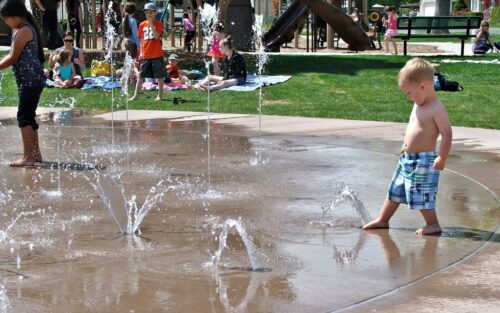

Cloward H2O wants to provided some advice for prospective purchasers of family water features in the areas of planning, safety and maintenance.
Urban environments, retail complexes, and leisure attractions that want to offer an alternative to the traditional pool frequently choose splash pads, also known as spray decks. These deck areas are often fitted with a variety of nozzles and above-ground spray toys, such as umbrellas, flowers, hydrants, and tipping buckets.
The first step in designing any kind of water feature is to hire a reputable design/engineering firm and confer with health and building departments who supervise project construction and issue building permits.
Accessibility and parking are key factors to take into account when choosing the location, and creative and intriguing approaches should be made to accommodate the site’s shape and contour.
“Splash Pads do not need to be round, square, or even flat – use your imagination!” says Bradley Clawson. “Research the types of features that are available but don’t feel limited to choosing from a single supplier. The engineer may even be comfortable incorporating custom features to get a specific unique effect.”
The manufacturer of each spray feature or toy will specify the “wet zone” or spray area as well as the needed flow (GPM) and pressure (psi). How close to the splash pad’s edge a feature may be installed depends on its spray area.
The design should feature appropriately sloping surfaces that are suitable for kids to play on and catch all the water in big enough drains, often greater than 1:50 (2% slope) but less than 1:15 (7% slope). The finished surface must be slip-resistant and durable to foot traffic. Another consideration is to design an attractive landscape setting and incorporate appropriate shade.
An engineer will utilize technical data to size a system to provide the required flow and pressure through a piping network and to the individual features when taking into consideration the mechanical system. The simplest, with a flow-through design, performs well on splash pads with less than 20 nozzles.
With certified backflow protection, potable water from a municipal line can be directly linked to the pipe network. If adequate city water capacity is not easily available, an alternative is to use it to fill a tank or cistern that is large enough to hold the required amount of water which will then be pumped to the features.
To keep the flow demand within the range of the supply, a controller can be used to limit the number of sprayers that can be triggered at once. However, many institutions discover that flow-through splash pad water may be collected, stored, and used for landscape irrigation and therefore conserve water. Water from the feature nozzles often moves across the sloped deck to a collection drain. Because water does not circulate, this kind of system does not need filtering or a sanitizing system.
A second system type treats water in an underground storage reservoir, or catch basin, using an autonomously recirculating treatment system, much like a swimming pool treatment system.
The size of the filtration and sanitation system is frequently a concern with splash pads. A well-designed splash pad that attracts a lot of people can quickly overload the treatment system. Instead of designing to the bare minimum required by code, operators should allow for increased popularity over time. For instance, a splash pad project in Springville, Utah, had a predicted 100-person capacity for instantaneous visits but has occasionally seen up to 600 people at once and more than 2,500 in a single day.
Operators frequently struggle with quick chloramine buildup in the water as a result of the high bather/water ratio. Chloramines, a consequence of inadequate chlorine sanitation produced when pollutants interact with low amounts of chlorine in the circulating water, are responsible for the bad smell associated with water bodies.
It’s crucial to properly size the chemical storage tanks and chemical dosing system to manage peak demand if proper free chlorine levels are to be maintained in the water. The choice of sanitizing chemical is also important, with Cloward H2O recommending liquid chlorine (sodium hypochlorite) or tablet chlorine (calcium hypochlorite) as two of the best solutions in combination with an acid feeder for pH control.
With these considerations in mind, there are considerable benefits to opening a Splash Pad. Cloward H2O reports that the aforementioned Springville Splash Pad has contributed significantly to increased business traffic in the small downtown area, with patrons travelling significant distances to visit. Whilst some traditional pools in surrounding communities have to routinely shut down for maintenance or high chloramine levels, Springville continues to enjoy the benefits of its Splash Pad, especially in the summer season.
Clawson adds: “By following the recommendations above, organizations contemplating whether to build one can have the reassurance that the investment and effort are well worth it!”
Cloward H2O details work on award-winning Four Seasons Resort - 13th Oct 2022
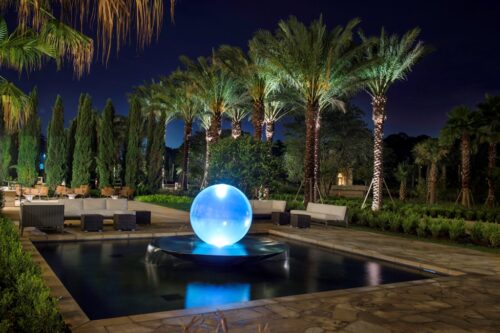
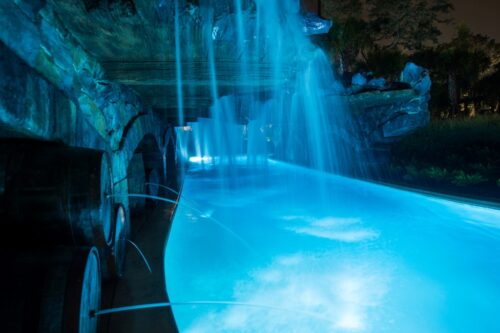
Cloward H2O, an expert in aquatic design, is celebrating its award-winning project at Walt Disney World’s Four Seasons Resort, an Aquatics International Dream Designs Winner and the only destination of its type in Central Florida to receive a coveted AAA Five Diamond Award.
Over 11 hectares of tranquil waterside splendor are included within the Four Seasons Resort in Orlando, Florida, US. A magnificent spa and salon, six lively restaurants, three Har-Tru tennis courts, and a championship golf course with a 16-acre practice facility are just a few of the resort’s amenities.
The hotel has a 5-acre private water park with a lazy river, two slides, a splash area, a family pool, and a free kids’ camp, whilst the adults-only infinity edge pool has underwater acoustics, is encircled by palm trees, and has cabanas. On TripAdvisor, the resort is ranked among the top 1% of all luxury accommodations worldwide.
Each guest room has a balcony with furniture and panoramic views, as well as a full marble bathroom. The resort has 68 suites available, including the opulently large Royal Suite, which can be expanded into a 9-bedroom home.
The Cloward H2O team designed all the aquatic amenities for the project included waterfalls, bubbling rapids, and spray features alongside an 11,000-square-foot lazy river. Water cannons, geysers, spraying columns, waterfalls, and an interactive choreographed splash deck fountain also all feature as part of the Kids for All Seasons Splash Zone interactive water feature alongside a selection of water bodies.
Numerous fountain features, a family infinity edge pool, a family hydrotherapy pool, an infinity edge formal adult pool, and a hydrotherapy pool are among the property’s water features.
The site layout of all water features, along with the accompanying mechanical systems (such as pumping, piping, water treatment, and water chemistry), hydraulic and electrical systems, as well as a detailed description of all pool conditions, was designed and engineered by Cloward H2O.
“This water complex needed the appropriate level of design sophistication,” says Damon Roberts, Project Manager. “The result was this water fantasy with amenities for every age and proclivity, and a meticulously implemented storyline whose aesthetic matches the resort’s overall architecture.”
The water facility was designed to resemble Florida’s heyday of Spanish Revival architecture, with two distinct areas, one for families and the other for adults, each taking a different approach to this design.
The adult area is situated closest to the main resort, where it is readily integrated into the hotel design. This area exudes a formal Spanish garden design for a sense of calm, with ample plantings and items aligned symmetrically along a perpendicular grid. Granite, travertine tile, and cast stone all contribute to the opulent atmosphere.
In a tribute to Florida’s past, Explorers Island, a family-friendly area, is styled as a 19th-century citrus plantation house. Explore the abandoned mansion tower, which also houses the climbing wall and slides.
According to the story, a Florida boil spring burst in the wine cellar of the estate and subsequently flowed out in the form of cascading waterfalls over a meandering river and wine barrel sprays. The mansion appears older than it is due to purposefully selected darker stone veneers.
A contemporary resort vibe is added by the use of travertine, glass mosaic tile, and modern furniture. To create the image of a natural Florida wetland, sabal palms in the area are purposefully leaning.
“The Cloward H2O team is committed to excellence and to the partnerships that bring iconic projects such as Four Seasons Resort to life. We are proud to be a part of a legacy of excellence, pioneering new aquatic attractions on a grand scale and engineering excellence that stands the test of time,” adds Damon.
Cloward H2O explores the secrets to making water rides work smoothly - 17th Sept 2022
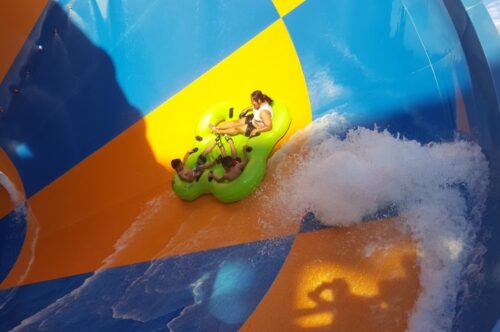
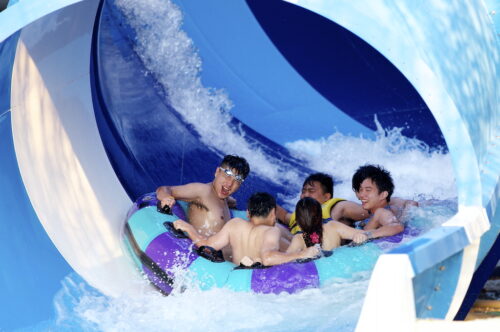
How do large water rides work?
“Firstly, we need to understand that there are two different mechanical systems at work on the water, the feature system and the treatment system,” explains Brad Clawson, a project manager at Cloward H2O.
Large water slides, like the one pictured above, have several different pump inlets where water is introduced into the flume. The first is at the top of the ride, and then additional water is added to either increase or decrease speed along the ride. Sometimes water is also added to send riders uphill
For a large multi-person raft ride with uphill and bowl portions, there are likely to be around five separate feature pumps, requiring around 200 kilowatts (kW) of power and moving around 7,500 gallons per minute (gpm).
At the end of the ride, there is a catch or plunge pool, for instance around 30,000 gallons, and there is also often an additional balance or collection tank, for instance around 8,000 gallons. This is hydraulically balanced with the pool to handle additional surge water needed in order for the slide to function properly.
The treatment system, which will need to be designed according to local codes, requires an additional 20 kW power demand, approximately, with the treatment pump servicing the filters and other water treatment components operating at around 700 gpm.
While making sure the waterslide functions properly with the appropriate flow rates, it is also important for waterpark operators to consider effective water quality control.
“Effective water quality control relies on the implementation of multiple methods as barriers to contamination,” says Clawson. “As technology and understanding improve, these methods increase the ability of engineers to design effective systems and operators to run them efficiently. Available technologies should be evaluated for suitability in each application.
“Though many alternative methods and products are available, the primary approach for water treatment should follow well-established parameters and standards.”
The four basic components of water quality management systems
There are four basic components of any active water quality management system, and these must all must work together to achieve consistent water clarity and maintain microbial control.
Circulation
Though local adaptation may be required; treatment circulation is sized with a flow rate such that a “turnover rate” sufficient to interrupt microbial life cycles and provide continuous monitoring is achieved.
“Circulation must ensure that water contained in the water body is well mixed and distributed, thus subjected to treatment. Typical turnover rates for slide plunge pools are 1 hour.”
Filtration
Filtration technology employed must be effective in removing suspended particulate material and debris from the water. Clarity standards are achieved by ensuring that water is circulated and that particles larger than the visual acuity threshold are removed. The bottom of the water body should be clearly visible from above.
“Maintaining water clarity better than 0.5 NTU or visibility of a 150mm Secchi disk in the deepest portion of the water is recommended,” says Clawson. “Regardless of other considerations, filtration is the key component not only for clarity but to reduce favorable living conditions for micro-organisms.”
Oxidation & Sanitation
Oxidation is the process of chemically reacting with dissolved contaminants for the purpose of destroying or converting them to a filterable state so that they are removed. Sanitation is the process of destroying microorganisms in the water.
“An excellent solution that can provide both sanitation and oxidation is ozone,” explains Clawson. “Return water is further dosed with a low-level residual of chlorine to further inhibit microbial growth in the main body of water. Providing a residual chlorine level in the water is required by health departments.”
“If numbers like 220 kW and 8,200 gpm are surprising, then getting aquatic designers and engineers on board early in the process will be helpful in making sure reality is kept in check during the design process,” adds Clawson. “Engineers are here to help protect the health, safety, and welfare of the public, especially at waterparks.
“But, engineers are also here to help make sure waterslides function properly, and that’s why doing what we do is not only work, but it’s fun.”
Cloward H2O celebrates success of Bass Pro Shop aquariums - 10th Aug 2022
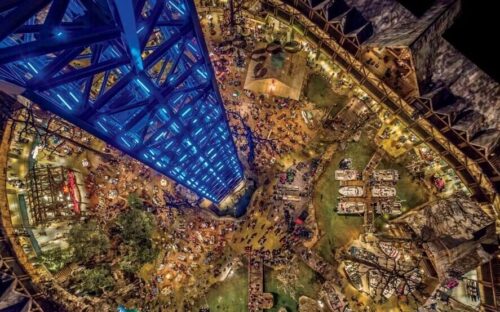
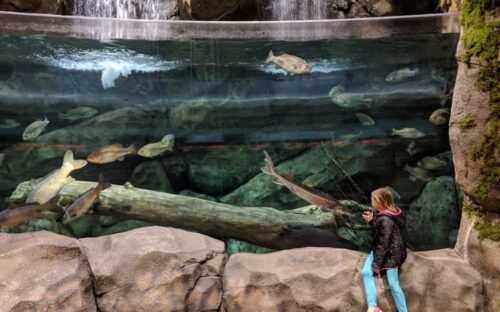
Cloward H2O reflects on the success of projects with a major sporting retailer in the US.
Cabela’s and Bass Pro are market leaders in hunting, fishing, and outdoor merchandise found throughout the US and Canada. Alongside the shopping experience, its stores frequently feature themed aquarium exhibits which showcase fish species typical of the local region of each venue.
Between 2005 and 2018, Cloward H2O collaborated closely with Cabela’s and Bass Pro Shops, being a major contributor to the expansion and renovation of their retail offering. The designer provided more than 100 aquarium exhibits, found throughout 60 different sites across North America.
The Cloward H2O engineering team heavily supported each store with structural engineering for water-containing structures and mechanical engineering for all Aquatic Life Support Systems, as well as back-of-house aquatic support and electrical power distribution and aquatic system automation controls.
Bass Pro Shops opened their much-anticipated headline superstore on 29 April 2015. Built within the former home of the NBA Memphis Grizzlies, the Memphis Pyramid, the conversion of the gigantic pyramid structure to an expansive destination retail experience has been widely documented.
One million people, over twice the population of Memphis itself, had visited the Bass Pro-operated Pyramid location by 4 August.
The Cloward H2O engineering team designed water features containing more than 400,000 gallons of water features, anchored by an indoor 1.5-acre Cypress Swamp and various other aquarium exhibits. Visitors will discover displays housing fish native to the Mississippi Delta, as well as live Alligators and waterfowl.
The pyramid is also home to the world’s largest collection of waterfowl taxidermy, an archery range, bowling, restaurants and the Big Cypress Lodge, with rustic-style accommodation.
“We wish to congratulate Bass Pro and Cabela’s on their tremendous growth and continued success in bringing their brand and products to regions across the US and Canada and we look forward to many more opportunities to support their effort to create a unique and exciting retail experience for their guests,” says Allen Clawson, principal and managing partner at the company.
Cloward H2O helps renovate Colorado’s Water World - 16th July 2022
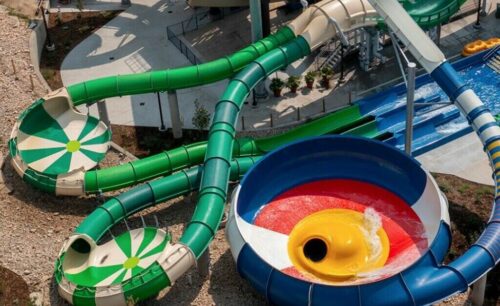
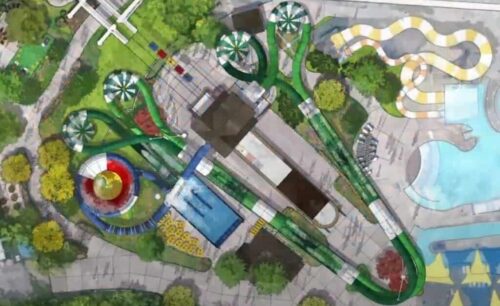
Cloward H2O has designed and engineered aquatic systems for one of North America’s oldest and largest waterparks as part of a major renovation now open to swimmers and guests.
Water World, found ten miles north of Denver, brought the first waterslides to the state of Colorado when it debuted in 1979. The following decades have seen a series of upgrades and expansions, leading to today’s seventy-acre site featuring over fifty attractions.
The latest expansion area is found near the gondola ride, remodeling the former Fun House Express, one of the industry’s first interactive water play structures, into a new Colorado-themed Alpine Springs zone. Among the new attractions are Roaring Forks, a two-lane ProSlide RocketBLAST water coaster, and the Centennial Basin, a ProSlide CannonBOWL, alongside social areas and cabanas.
The engineering and construction teams had to use creative solutions to create a design that worked around existing infrastructure, facilitating new mechanical systems, pumps and pipes. Working with Cloward H2O and ProSlide Technology was site designer DTJ Design who worked closely with the Water World operations team to ensure the new attractions ran smoothly from day one.
Allen Clawson, Cloward H2O principal, grew up locally and visited the park almost forty years ago.
He says: “It was gratifying to me personally to work with this fantastic facility that has operated so successfully for more than four decades. These new slides complement the classics that I remember as a kid and continue bringing new excitement to park guests.
“Cloward H2O congratulates Water World and the development team for the successful completion and opening of these two new attractions.”
Cloward H2O looks back at gulf resort investment - 12th May 2022
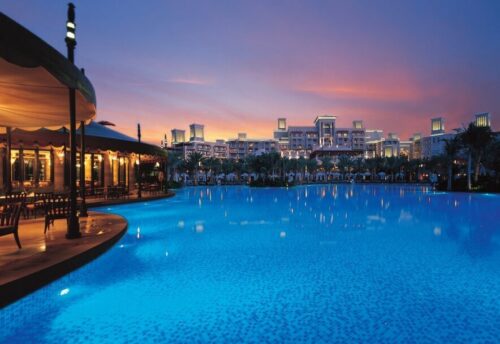
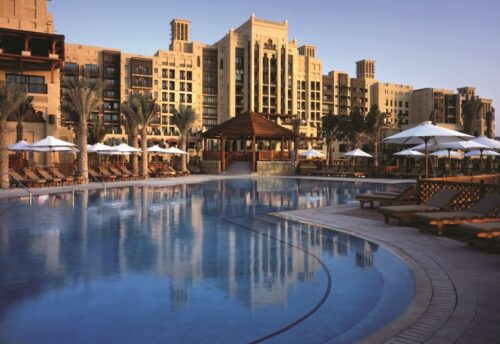
The Madinat Jumeirah Resort is one of the largest luxury resort properties in Dubai on the Arabian Gulf.
Resort guests can enjoy a variety of aquatic experiences including fountains and pools, accompanied by a complex 5.4 km saltwater water system connecting the resort’s amenities. This provides the ideal network for guests to transverse by Abras, the traditional Arabian fishing boats.
The resort, boasting authentic Arabian themes, opened in September 2003 as what the firm calls “a destination of unique qualities and outstanding beauty”.
The expansive accommodation comprises two boutique hotels and courtyard summer houses which can benefit from facilities including a traditional souk, a Six Senses Spa, and a wide range of recreational facilities such as the resort’s Quay Health club. Madinat Jumeirah Resort is also home to one of the region’s leading conference and banqueting centres.
Cloward H2O was involved in aquatic amenities engineering and design for the Middle Eastern project. The firm says its team conducted the project with industry best practices in mind, ensuring its client benefited from long-term efficiency and satisfactory quality. Cloward H2O used state-of-the-art technologies and customized solutions to ensure safe and crystal-clear water for Madinat Jumeirah.
Damon Roberts, project manager at Cloward H2O says, “ we are grateful for the friendships that were made on this iconic project and to be able to continue designing and creating projects with these momentous companies. Cloward H2O is proud that this one-of-a-kind resort has stayed in pristine operation for almost 20 years.”
The firm worked alongside Africon, DSA Architects International, EDSA, Jumeirah International and Mirage Mille Leisure & Development for the project.
Cloward H2O reflects on built-to-last project at uShaka Marine World - 17th Mar 2022

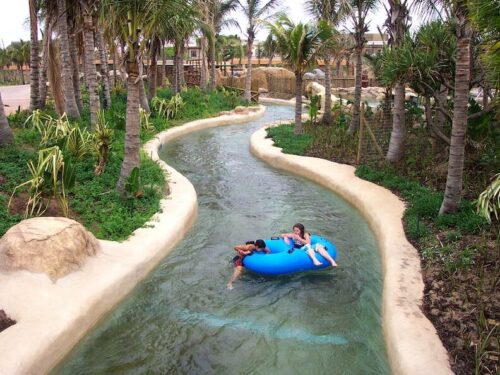
Cloward H2O is looking back at the work it completed for uShaka Marine World in Durban, South Africa, almost two decades ago. The firm was the aquatic specialist for this large-scale project, a 16-hectare theme park with eight different attractions: uShaka Sea World, uShaka Wet ‘n Wild, uShaka Sea Animal Encounters Island, uShaka Beach, uShaka Village Walk, uShaka Kids World, uShaka Dangerous Creatures and Chimp & Zee.
The company provided aquatics expertise for the aquatic complex, encompassing the uShaka Sea World aquarium and the uShaka Wet ‘n Wild water park.
uShaka Sea World
With more than six million gallons of water, uShaka Sea World Aquarium is the largest in the southern hemisphere and features a unique themed entrance with a realistic 1940s cargo ship shipwrecked beside the snorkeling lagoon. Guests enter through a “labyrinth of shipwrecks” and can discover 350 species of fish and other sea life.
The aquarium also holds one of the biggest variety of sharks in the world including bull and ragged-tooth sharks, and its penguin exhibit is home to more than 63 African penguins. Visitors can enjoy interactive activities at this attraction, for example, snorkeling, touch pools and a rocky reef exhibit.
Other highlights include the Open Ocean and Dangers of the Deep exhibits, as well as the Coral Gardens and the Deep Zone.
uShaka Sea World houses the research facilities of the Oceanographic Research Institute (ORI), and the South African Association for Marine Biological Research (SAAMBR).
uShaka Wet ‘n Wild World
At Wet ‘n Wild, guests can enjoy separate swimming pools for kids and adults, relaxing river rides and high-speed chutes for the adrenaline junkies. The attraction is also home to the highest slide in Africa, which is 72m long, six stories high and at a 30-degree inclination.
For younger guests, there is a mini-super tube and a play area with a water cannon and water mushrooms. Meanwhile, older guests can experience the Open-body ride – sometimes referred to as the washing machine. This is a high-water volume ride that accelerates riders through bends at a rate of about 4-5 meters per second.
Other rides include the Tunnel – a roller-coaster enclosed ride speeding round the curves at four meters per second – as well as the Kamikaze speed slide, Stuka Speed slide, Five Lane Racer, and the Fast River ride, or relax into the Family Rafter.
The freshwater entertainment venue operates year-round.
Cloward H2O celebrates approval of DSRT Surf Resort - 17th Feb 2022
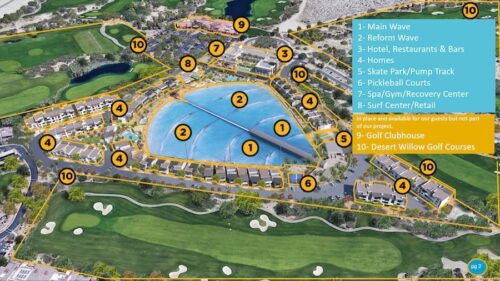

Cloward H2O has been working alongside Beach Street Development, Architects Orange, The Altum Group, Coffman Engineers, and Wavegarden on the DSRT Surf Resort in California for nearly 5 years, and is celebrating the project’s recent final planning approval.
DSRT Surf Resort, which is expected to open in 2023, will be the world’s first fully-integrated inland surfing resort. The project will add a new surfing and outdoor attraction to the Desert Willow Golf Resort in Palm Desert.
The 18-acre site will include a 92 key surf destination hotel, with pools, hot tubs, a restaurant and bar, and 83 privately-owned residential villas, featuring views of and access to a 5.5-acre surf lagoon.
The innovative new surf centre will provide world-class facilities, with waves for everyone from beginners to pros thanks to the Wavegarden Cove surf technology. Visitors can enjoy a surf academy, retail and rentals, alongside a pump track, putting greens, pickleball and an upscale spa facility.
“We are thrilled with the recent unanimous approval by City Council and Planning Commission, moving the project past final entitlement,” says Allen Clawson, principal at Cloward H2O.
“Surf parks have the ability to bring the sport to any location, making it more accessible to a wider audience. Modern surf wave technology produces the perfect wave several times per minute, consistently pumping waves in the same location each time.
“DSRT Surf provides an accessible, safe, and predictable means for the practice of the sport allowing surfers to perfect their turns and air or just enjoy time on the water without worrying about dangers such as rocks, reefs, riptides, or sharks.”
Costing over $200 million, DSRT Surf aims to bring new economic opportunities to the area by providing a year-round destination. It is expected to create more than 400 jobs in Palm Desert.
One notable part of the project is a unique “Turf for Surf” program, which will offset water used by the surf lagoon by converting portions of the adjoining golf course with desert landscaping. This is key for a location that is challenged by drought conditions, and a project that will need around 54 million gallons of water a year. This amount is more than offset by water use reduction to the golf courses.
“It may seem counter-intuitive, but water use by the surf lagoon is considerably less than what is needed for an equivalent area of irrigated golf course. It is also less water per area than developing into residential condos. In fact, the entire impact of this development is equivalent to 38 single-family residences,” says Clawson.
Cloward H2O is honored to have an integral role in the design and engineering of the DSRT Surf project and is looking forward to seeing the destination take shape as the construction phase is now set to begin.
Cloward H2O looks back at beachside project - 24th Jan 2022
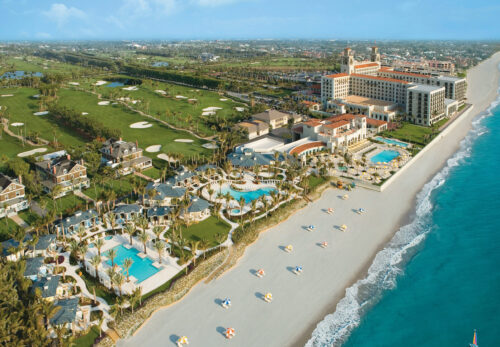
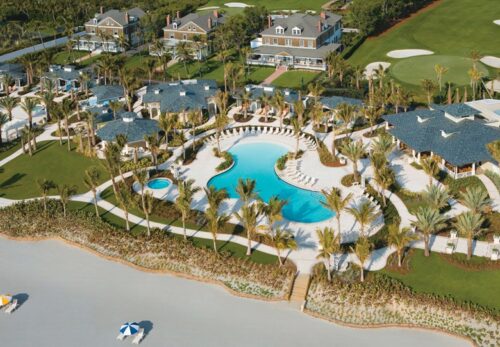
Cloward H2O worked alongside a talented team to manage the engineering design for a renovation of the resort which has its origins in the late 19th-century.
Cloward H2O worked on the design of water features for an expansion of The Breakers’ Beach Club facilities, including the installation of a luxury relaxation swimming pool, activity swimming pool, three Jacuzzi spas and a fountain feature.
Constructed in 1896, The Breakers is a luxury oceanfront hotel providing views across some of Florida’s most beautiful beachfront stretches.
As one of North America’s most iconic resorts, The Breakers is listed on the National Registry of Historic Places. During the Second World War, The Breakers was temporarily converted into the US Army’s Ream General Hospital. Thousands of servicing individuals used the venue to recuperate from illnesses and wounds during the war.
Moving into the 21st century, The Breakers is now used for couples to escape the strains of everyday life, relaxing in upscale accommodation besides Palm Beach.
Some of the unique selling points of the resort include its contribution to minimizing its impact on the environment, improving community wellbeing, and its premium status as an AAA Five Diamond property.
One of project manager Rob Cloward‘s first projects at Cloward H2O was at The Breakers. In 2004, Rob worked with the resort team to design and plan a long-term amenity area that would complement the heritage and luxurious feel of the existing resort and buildings.
The pools were requested by the operators to create new intimate spaces from which guests would have spectacular views of the resort and the nearby ocean sands.
Respecting the resort history and ensuring future sustainability was a key priority, and due care was taken to prepare for this during the works. Measures including extensive added soil and rock layer undegrading as well as strong-form shotcrete and concrete would keep the structure free from the prospective dangers of environmental erosion, close to the coastline.
The beach which surrounds the resort is used by sea turtles as a nesting ground, so special considerations were implemented into the designs so that the turtles’ nesting patterns were not disrupted.
Sea turtles can be very sensitive to focused and bright lights, with artificial lights disorientating newborns as they travel from nests to the sea after hatching. With this knowledge, Cloward worked carefully to minimize light levels around the resort’s pools, ensuring turtles will be safe as well as hotel guests.
The resort reinvests approximately $30 million annually into revitalization projects, including its pools, that help keep the resort’s history alive. Such projects have ensured that The Breakers could celebrate its 125th Anniversary last year. Corry Cloward managing partner and president at Cloward H2O says “we are proud to have been a part of this historic hotel’s history to help keep it luxurious and alive for many years to come.”
Cloward H2O announces new whitewater project in Montgomery, Alabama - 15th Nov 2021
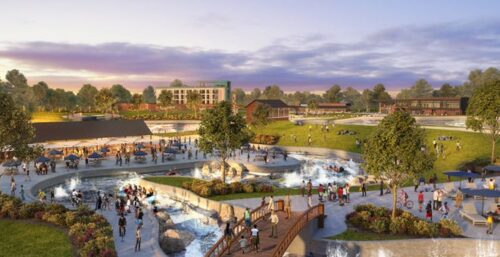
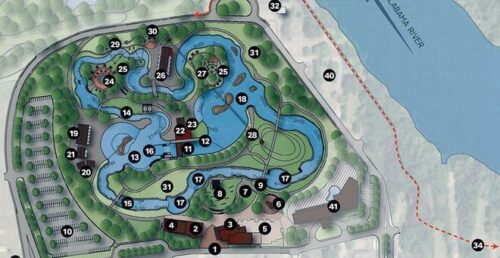
Cloward H2O, an expert in aquatic design, is working on the new Montgomery Whitewater Center, alongside S2o, Liquid Design and GMC. The new whitewater and outdoor recreation facility sits on a 120-acre site in downtown Montgomery, near I-65, and aims to redefine the area as a young professional and family destination.
The centre, which is set to open in summer 2023, will feature whitewater rapids that wind through shops and restaurants, as well as other attractions such as a zip line tower. The plans also include an outdoor performance venue, a hotel and a conference centre.
The project was approved in 2019 and construction started in summer 2021. Once complete, the Montgomery Whitewater Center is expected to employ over 125 people.
“This is not your typical pool,” says Allen Clawson, principal overseeing the project for Cloward H2O. “The structural, waterproofing, and mechanical systems employed to manage and contain the 10,000,000 gallons of very active water are somewhat complex, as you can imagine.”
For this project, Cloward H2O is providing engineering services for the pump station, upper and lower basins, river channel structural and waterproofing. It is also working on whitewater flow circulation pumping, water quality management systems, control and automation systems, as well as several specialty items such as conveyor systems, slalom gates, and obstacles within the course.
Braden Steiner, project manager for Cloward H2O, says that the technical challenges are overcome through the application of the firms broad and diverse aquatic engineering experience: “We have been fortunate to be able to apply our experience with other large venues in tackling these challenges.”
The facility, which will be one of a few recirculating whitewater parks in the country, features two separate river channels providing an Olympic standard course and a dynamic recreation channel, bringing whitewater rafting to an accessible location. Visitors will also be able to enjoy climbing, zip lines, mountain biking, rope courses and more.
The rapids will include 10,000,000 gallons of surging whitewater. To power this, the pump station will employ five 750 Hp vertical turbine pumps for a total of 500,000 gpm, enough to fill an Olympic sized swimming pool in less than 80 seconds, feeding the two whitewater channels which are designed to drive class III, IV, and V rapids.
This will also serve as an Olympic training facility and will host world-class competitions, as well as providing first responder training. The projected annual visitation is around 300,000.
The Montgomery Whitewater Center will bring the thrill of whitewater parks to visitors of all ages and experiences in a safe, controlled environment.
Cloward H2O highlights man-made lake restoration at Vidanta’s Nuevo Vallarta Resort - 15th Oct 2021
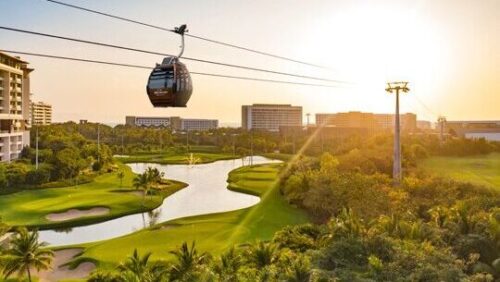

Cloward H2O worked with Grupo Vidanta on a permanent solution for some of the challenges with its man-made lakes at its flagship resort property in Puerto Vallarta. These lakes add to the atmosphere of the destination, however, as a result of runoff from the surrounding landscape and the process of eutrophication, they had developed algae growth, sludge deposits, unpleasant vibrant green color, foaming, and foul odors.
Cloward H2O’s aquatic engineering team worked on solutions to restore the lakes, providing engineering for augmentation of existing infrastructure with key components to solve the lakes’ hydraulic, water quality, and high nutrient (nitrogen & phosphate) issues.
Eutrophication is the build-up of nutrients, leading to dense plant & algae growth, stratification, decay and anaerobic conditions. To solve the issue, project manager Dan Aldred, principal Allen Clawson and their team took inspiration from nature, aiming to replicate the process that takes place in natural lakes.
The engineering team looked at conditions in the existing lakes to identify the key factors and locations where augmentation would have the largest overall impact on water quality. They discovered that insufficient circulation and flow patterns were causing stagnant areas within the lakes.
To resolve this, Cloward H2O brought in a redesigned circulation system, featuring pumps, inlets, outlets and waterfalls that work to direct flow, allowing the water to move and circulate.
Water quality was also improved by removing suspended material from runoff and algae growth. The team added water treatment modules to the circulation system, to boost water clarity and sanitation. The technologies used include low-waste and high-capacity filtration, along with chemical-free ozone for highly effective oxidation and sanitation, resulting in clean, clear water.
Algae growth is encouraged by high levels of nitrogen and phosphates. Cloward H2O analyzed the nutrient inputs and outputs of the lakes and introduced measures to reduce runoff, treat the source waters, and provide beneficial plant growth. This helps to balance the nutrient loads. Now, combined with the improved hydraulics, filtration and sanitation, algae growth is limited, and a healthy balance is maintained in the lakes, year-round.
“Engineered solutions for optimal hydraulic flow, reduction in suspended solids, oxidation, sanitation, and healthy nutrient balance effectively restored Vidanta’s man-made lakes to the attractive and beautifying asset they were meant to be,” says Clawson. “Cloward H2O is pleased to have been entrusted with delivering “Water Perfected” in this meaningful project and partnership with Grupo Vidanta.”
Cloward H2O looks back at success of fountain project in Centennial Olympic Park - 28th Sept 2021


Cloward H2O is celebrating the longevity and legacy of one of its earlier projects, The Fountain of Rings, which is the centerpiece of Centennial Olympic Park in Atlanta, Georgia. Completed in 1996, it is now visited by millions of guests each year, both local and international.
The Fountain of Rings is the world’s largest interactive fountain, featuring the Olympic Rings symbol, and was created especially for the 1996 Summer Olympics. It is set in a 21-acre park that serves as Georgia’s lasting legacy of the Centennial Olympic Games, as well as anchoring efforts to revitalize residential and commercial development in Atlanta.
Cloward H2O provided consulting engineering services for the original design of the fountain prior to the opening of the 1996 Summer Olympic Games.
Visitors can enjoy a unique fountain show and splash pad, with computer-controlled lights and jets that are synchronized with music. The fountain’s jets can shoot 12 to 35 feet in the air. It was designed by Cloward H2O for both show and play, and park-goers often use it to cool off on hot days.
This computer-controlled fountain concept has since been replicated in other urban designs such as Dundas Square in Toronto and in commercial uses such as the Bellagio Fountains at the Bellagio Hotel & Casino in Las Vegas, Nevada.
There are flags for each of the countries to host a Summer Olympics previous to the event in 1996, surrounding the foundation area, as well as eight 65-foot-tall light towers that echo the design of classic Greek columns. The park also features several sculptures, such as a statue of the father of the modern Olympic Games, Pierre de Coubertin, as well as a small amphitheatre.
Centennial Olympic Park is the biggest downtown park built in the country in the last 25 years. AS well as the fountain, it is also home to playgrounds, green spaces, and a small stage. Visitors can also visit nearby attractions such as The Coca-Cola Museum, the Aquarium, Children’s Imagine IT Museum, the CNN Center and Georgia Dome.
“Cloward H2O is proud to have been a part of this unique and special attraction space in Georgia as the fountain has remained in operation for more than 25 years,” says the company.
The fountain itself is operational every day of the year, often doing four shows per day.
Cloward H2O recognized in Aquatics International’s Dream Designs awards - 6th Aug 2021
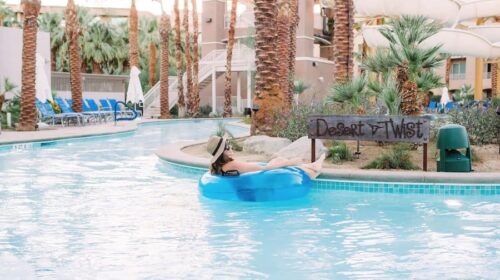

Cloward H2O has announced that two of its recent projects have been named in this year’s Dream Designs awards by Aquatics International.
The company was the aquatic designer/consultant for Tidal Cove Waterpark in Aventura, Florida, and the architect & aquatic designer/consultant for HyTides Waterpark at the Hyatt Regency Indian Wells Resort & Spa, in Indian Wells, California.
Tidal Cove
The five acres Tidal Cove boasts the most slides and activities in Miami Dade County. It is home to a 60-foot tower with seven slides, a lazy river and a three-rider surf simulator. There is also a kids waterplay tower, an entry pool and an oasis pool. It has been voted as one of the top 10 new attractions in the country, according to USA Today’s 10 Best Readers’ Choice 2020 Travel Awards.
Highlights include two steep drop slides, a family-style raft boomerango slide, a multi-lane Whizzard High-speed enclosed tube slide for racing and the world’s first double tube master blaster water coaster, as well as a double tube Constrictor ride. Rides were provided by WhiteWater.
The landscaping of the resort is modern and simple, with many palm trees included to make it feel like a tropical getaway. One challenge that the Cloward H2O team faced was the fact that the pools and structures had to be built on piles because of the high groundwater and the swamp-like land area. Engineering design accounted for this, so no significant settling or future water rises will affect the structural integrity.
Speaking about some of the design decisions, a spokesperson from the company says:
“The different pools were designed to create separate spaces in the landscape within the overall pool amenity area. This allows for a more intimate feel to each space while still providing the full variety of features.
Meanwhile: “The Kids Cove was meant to be a fun, whimsical area within the overall amenity. The landscaping sets this area apart from the other pools and creates a unique experience for the kids. Rather than creating a mythical or fantasy type theme that might feel contrived, the design team chose to go play with summertime staple – the ice cream and candy shop.”
HyTides Waterpark
HyTides Waterpark at the Hyatt Regency has a large 4230-square-foot pool with an iconic water tower and two tube slides. There is also a 2073 square-foot kids pool and a 912-square-foot splash pad, as well as a 547-foot river pool. Prior to this project, existing amenities include a desert pipewave slide, food and beverage options, a turf lawn, cabanas and a wood deck.
The expansion has allowed the resort to cater to more guests and add more entertainment options while keeping its classic feel. The resort is located in an area where water is a valuable resource. Using cutting-edge technology and detailed calculations, Cloward H2O was able to significantly reduce water usage and power necessary for such an amenity.
“Many challenges were overcome in the renovation of under-utilized space on the grounds to create HyTides Waterpark at Hyatt Regency Indian Wells Resort & Spa including opening in the midst of pandemic conditions,” says the company.
“Successful projects always involve close collaboration and partnership between the owner, design, and construction team. It was a great pleasure to work with EDSA, Inc., TERRA Engineering, Ltd., Pinnacle Design, WhiteWater, Hamel Group of Companies, CalCom Pools, and Hyatt on this beautiful resort renovation project.”
The expansion included the addition of a unique water tower, designed to fit within the resort setting instead of the typical steel towers often seen in waterparks, as well as providing a memorable view.
“Hyatt was a challenging renovation project,” says Allen Clawson, Principal. “The desert environment added many constraints along with infrastructure, including part of a feature lake existing in an underutilized portion of the property. Facilitating water use was a key priority for our team.
“We wanted to bring new life to this much-loved resort but also make it environmentally and economically friendly. Our team was up to the task and guests now have an inviting new experience awaiting them at their stay.”
Cloward H2O celebrates past project at Sandy Lane Resort & Spa - 23rd Jul 2021
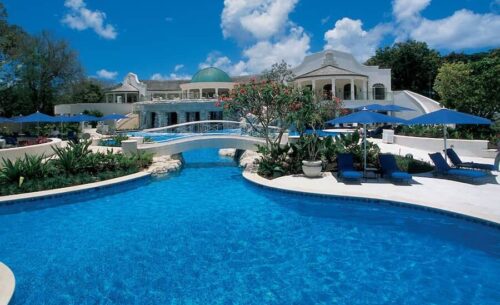

Cloward H2O is reflecting on the success of one of its key built-to-last projects at Sandy Lane Resort & Spa. This luxury Caribbean resort features multi-level pools and spas, as well as five hydrotherapy pools, a penthouse swimming pool and numerous koi ponds, fountains and wading areas.
Guests can enjoy the 47,000 square foot spa, four restaurants, seven bars and three golf courses when they stay at the resort, which boasts 112 guestrooms and suites as well as a five-bedroom villa.
Cloward H2O provided complete engineering design and construction administration services for the elegant multi-level pool and waterfalls, the hydrotherapy pools, the rooftop penthouse swimming pools, three koi ponds and numerous fountains.
This s scope of work included the design of all mechanical systems for the water features throughout the resort including pumping, piping, water treatment, water chemistry, waterproofing, structural detailing and design. In addition, the company worked on the electrical and mechanical designs including wiring, control diagrams, motor control centres, chemical monitoring, control systems and underwater pool lighting.
The resort has hosted many of the rich and famous and is also a much-loved family destination. Two of its world-renowned golf courses are 18-hole championship courses, designed by Tom Fazio. It also has one of the region’s largest spas, with a wide array of treatments on offer.
Sandy Lane has won many awards throughout the years. It is an AAA FiveDiamond Rated Resort and a Forbes Travel Guide Five-Star Rated Resort.
“Sandy Lane is the example of expert engineering and the collaboration of a great project team,” says Rob Cloward. “Cloward H2O is never alone on any project and the design partners that brought their expertise to the project understood how to make this resort great. We are pleased to see Sandy Lane continuing to be successful, it’s the hope of every project to be a built to last facility.”
Cloward H2O’s work at Hilton Waikoloa Village is built to last - 4th June 2021
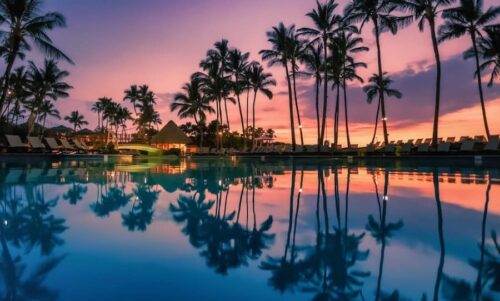
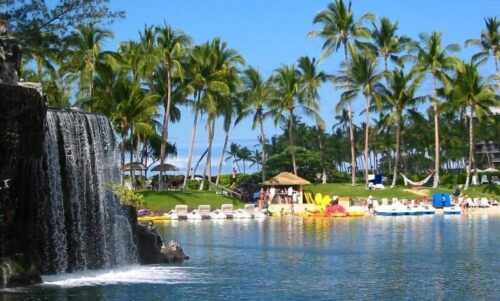
Cloward H2O is celebrating the success of one of its earlier projects, Hilton Waikoloa Village, where it provided engineering design for a three-quarter mile long saltwater boat way river with waterfalls and cascades, as well as three major pools with waterfalls and water slides and two major freshwater bird and fish exhibits with decorative waterfalls and cascades.
The company also worked on the swim with the dolphin exhibit and the saltwater lagoon that guests can snorkel in at the resort, which opened in 1988 as the Hyatt Regency Waikoloa and then became the Hilton Waikoloa Village in 1990.
The 62-acre resort can be found on a nine-mile stretch of the Kohola coast and is home to a four-acre ocean-fed saltwater lagoon, where visitors can swim and snorkel with sea turtles and tropical fish. Guests can also enjoy an interactive dolphin guest program, seven tennis courts, two 18-hole championship golf courses and the 25,000 square foot Kohala Spa. They can even ride between guest rooms on canal boats or air-conditioned trams.
Those wanting to relax or have fun by the pool have a choice of three swimming pools, with a range of waterfalls and slides as well as jacuzzis and a sand bottom play area. There is also an adult-only pool, complete with three luxury cabanas.
There are 1,113 guest rooms and 58 suites available, and the resort also offers a 20,000-square-foot shopping area, a ¾ mile-long museum and art walkway and award-winning dining.
The resort also features Dolphin Quest Hawaii, the only dolphin interaction of its kind on the Big Island, where guests can see dolphins close up and help to support marine conservation and education by taking part. This is an outdoor experience with extra safety measures to keep everyone safe during the pandemic.
Cloward H2O thinks outside the box for Bountiful Plaza’s new splash pad - 20th May 2021

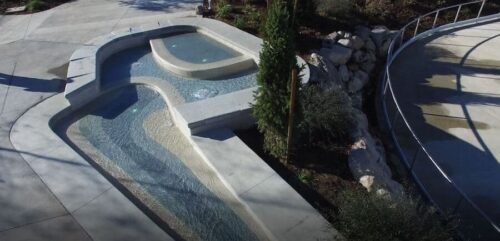
Cloward H2O was asked by Environmental Planning Group (EPG Design) to work on a splash pad for the Bountiful City Park in Bountiful, Utah. This was a unique project which required a deep understanding of engineering principles, as well as some extra thought and innovation, in order to succeed.
The new splash pad involves a small headwater fountain at one end of the park, spilling over into an artistic, man-made shallow canal. This runs along the edge of the park and into a large water fountain, where visitors can enjoy cascading falls, spraying rocks, interactive features, bubblers and more.
Before starting work, the company needed to make sure that all applicable building and pool codes would be followed, as well as ensuring its own internal safety standards were met.
“We place safety as our primary concern at Cloward H2O and will not stamp a drawing set that does not meet all the codes and safety protocols,” says Dan Aldred, Project Manager at Cloward H2O. “Then, as we got further into the design, we found other challenges like elevation issues with the sewer being higher than expected. We engineered a special elevated sump for backwashing and for draining the collection tank.”
In addition to designing the system to meet all the required codes, the company also made sure that it is able to provide full secondary sanitation, in order to guarantee enhanced water quality, better sanitation and savings of 40 – 50% on traditional water treatment chemicals. Furthermore, the use of VFDs on all pumps lead to around 15% power efficiency improvement.
“As always, the most important factor to the success of any project is the team,” says Cloward H2O. “We are grateful to all our partners and friends that trust us to help them with these spectacular projects. It is always a pleasure to work with EPG and we appreciate the creative challenges that they put to us.”
For this project, Cloward H2O provided creative design assistance with EPG, as well as structural engineering for the various elements across the site, mechanical engineering for all piping, water treatment systems, and activation of the multi-faceted features and electrical design for optimized control and automation of all systems including feature lighting.
“It was a pleasure working with EPG, VCBO, Spectrum, and AeUrbia on the Bountiful Plaza water feature project,” said Dan Aldred.
“They are great designers, excellent communicators and do a great job of smoothing out the inevitable bumps. The final project turned out amazing and if you haven’t already seen it then take an afternoon to enjoy Bountiful City’s newest and coolest water feature.”
Cloward H2O looks back at successful Mohegan Sun project in Connecticut - 22nd Apr 2021
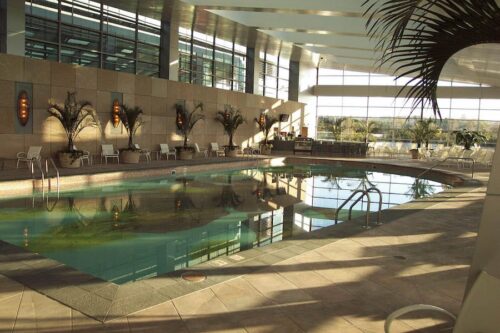
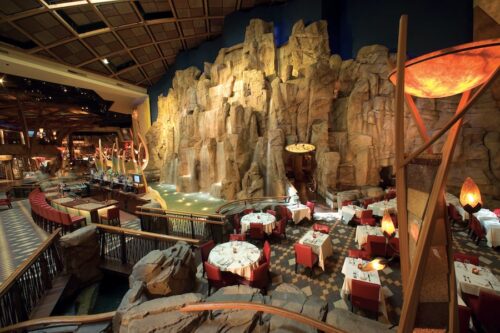
Cloward H2O is looking back at one of its built-to-last projects, Mohegan Sun in Uncasville, Connecticut, a leading entertainment, meeting and gaming destination.
The company provided design and full engineering services for the resort’s 10,000-square foot indoor swimming pool, as well as several hydrotherapy spas and a striking indoor hotel lobby water feature.
The resort, which is located on 240 acres along the banks of Thames River, was the largest private development project on the East Coast when it opened in October 1996. It is home to a 1,200-room luxury hotel, more than 100,000 square feet of meeting and events space, and130,000 square feet of retail space, as well as nine restaurants, a 10,000-seat arena, 115,000 square feet of gaming space, a 300-seat cabaret and a world-class spa.
There is also a business centre, a 10,000-square-foot indoor pool, a 17,500-square-foot sun terrace and an FEC called Kids Quest. The resort, designed by Kohn Pedersen Fox Associates, features Mohegan tribal-inspired interiors by the architect David Rockwell and the 34-storey hotel tower is home to 1,200 guest rooms designed by Hirsch Bedner Associates.
As well as working on the indoor pool and spa facilities, Cloward H2O’s input included design and engineering for a dramatic water feature in the hotel lobby, where water flows from a reflecting pool and through a stream to the base of the 40-foot high Taughhanik Falls.
“Cloward H2O is grateful to have been a part of this talented project team and that the resort still operates with first-class efficiency and standards,” says Corry Cloward, managing partner and president of Cloward H2O.
Cloward H2O on the rise of in-land surfing - 15th Mar 2021
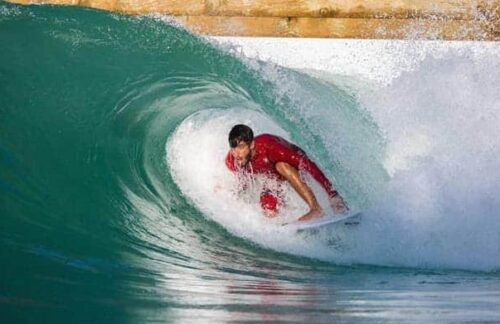
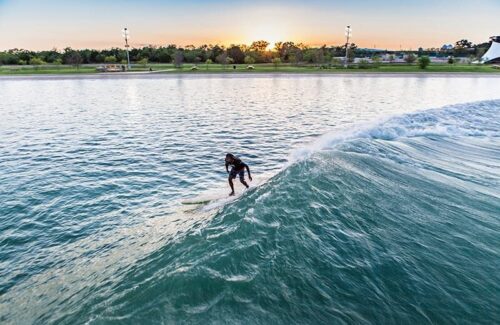
Cloward H2O has over 45 years of experience in the field of recreational water and has worked on the engineering of numerous surf venues over the years. In-land surfing will continue to be a growing trend, with four new commercial facilities opening in the last year, doubling the worldwide total.
Surf parks are gaining popularity as they allow surfers of all levels to enjoy the sport and to work on their skills in all weathers, rather than having to wait for nature to provide the perfect waves. Surf parks are ideal for both recreation and training, as well as hosting competitions.
Starting with its work on Sun City in 1987, Cloward H2O has been involved in several in-land surf projects, both modern and classic.
“No other aquatic engineering firm can match our experience or proficiency in regard to the unique requirements involved in developing a Surf Park Venue,” said Allen Clawson, Principal and Managing Partner at Cloward H2O.
“Cloward H2O has been proactively involved in the evolving regulatory status affecting Surf Parks serving on joint committees with ASTM, NSF, CMAHC and others as the industry works to get a handle on the complexities involved in a growing sector of our industry…since Sun City in South Africa first opened to the public, Cloward H2O has been delighted to continue to work in the realm of recreational lagoons and surf venues.”
Surf parks have the ability to bring the sport to any location, making it more accessible to a wider audience. Modern surf technology can produce the perfect wave several times per minute, consistently producing waves in the same location each time. In-land surf venues are also a safer option, allowing surfers to enjoy the past time without worrying about dangers such as rocks, riptides or sharks.
To create a successful surf-park, mechanical wave-generating technology must be carefully matched with specific bottom profile geometry (bathymetry). This combination causes the wave to perform as desired and is able to produce waves for everyone from beginners to professionals.
While wave pools, such as Disney’s Typhoon Lagoon in Orlando and Sun City’s Valley of Waves in South Africa have been around for many years, a new generation of surf wave technology is now available. This allows for larger format waves, longer runs, bigger faces, programmable waves, and barrels that are comparable with the world’s top surf spots. Now, the industry is on the verge of the next evolutionary step.
As well as the wave technology, water quality management is also key to a successful in-land surf venue. Unlike traditional wave pools found in waterparks, modern surf venues can cover several acres and contain millions of gallons of water. And dirty water is undesirable, unhealthy and uninviting to guests, no matter how cool the wave technology is.
Cloward H2O to help design emergency response centre at Houston Community College - 17th Feb 2021
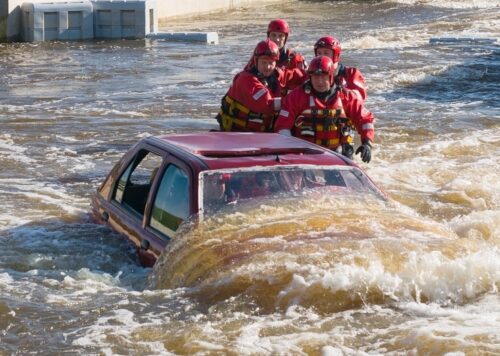
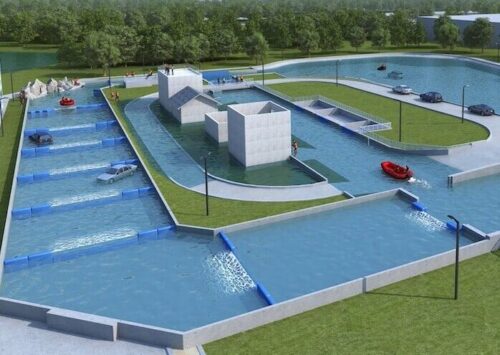
Cloward H2O has been engaged to design and engineer Houston Community College’s Regional Response Operations Center (RROC), alongside S2o Design, Huitt Zollars, and local civil, structural and MEP firms.
Floods are a frequent danger along the gulf coast of South Texas to Florida, and Houston Community College has a long history of training first responders to help with this hazard. Now, in a bid to improve the emergency response in the region, it will expand its existing first responders training facility by creating the RROC.
The expansion project will result in the college being able to offer dedicated training for three to four thousand public and private fire, law enforcement, emergency medical and rescue responders each year, giving them the technical skills necessary to perform urban flood and swift water rescues.
The facilities will enable trainees to practice aerial and boat rescues both day and night, experiencing real-life disaster scenarios under controlled conditions.
The design includes a 2.5-acre flatwater pond, variable configuration swift water channel, as well as an urban flood simulator with mock-up buildings and a low head dam simulation. Here, trainees will have the opportunity to use real-world rescue vehicles in a range of scenarios.
The design also features re-configurable obstacles and movable equipment, so there will be complete flexibility to sculpt the swift water channel into a wide range of rescue training scenarios as well as the ability to vary the hydraulic conditions dynamically.
“Cloward H2O takes on the various engineering challenges presented in this project with an imaginative and perceptive approach,” said Braden Steiner Project Manager for HCC. “Our role is key to the integration of mechanical and structural systems enabling flexible configuration for a wide variety of realistic but controlled hydraulic conditions and simulations throughout the facility.
“Water quality management is also of paramount importance and is particularly challenging, requiring specific attention to high levels of potential contamination from the boats, trucks, and rescue gear being utilized. Cloward H2O is honored to work with the HCC administration, design team and regional responders to achieve this monumental goal and improve the capabilities of responders throughout the region.”
Cloward H2O’s work at Geyser Falls Water Theme Park is built to last - 11th Jan 2021
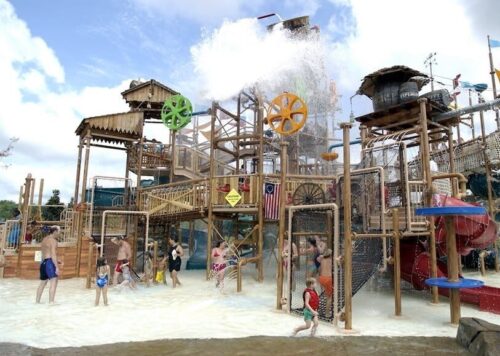
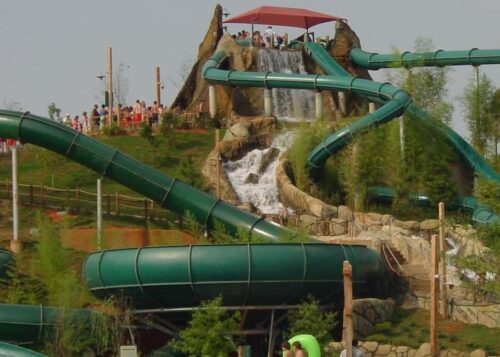
Cloward H2O is looking back at one of its successful projects from the past, Geyer Falls Water Theme Park at the Pearl River Resort in Choctaw, Mississippi.
Planning for this project began in 2001 and it was completed in 2003, with Cloward H2O providing full engineering design services for the park including site civil, electrical, and mechanical engineering as well as engineering for all water features.
Geyser Falls Water Theme Park is based on a Choctaw Indian legend of a magical land, filled with gushing geysers and roaring waterfalls. At the park, guests can enjoy a wave pool and a lazy river, alongside waterfalls and 12 slides. There is also a four-storey water play factory and a tot’s water play area with over 350 custom jets.
The attraction is also home to Backsplash!, a WhiteWater Boomerango which was the first slide of its kind in the country at the time, alongside the bubbling pools, steaming vents and erupting geysers of Geyser Flats.
A team of now-retired industry experts worked on the project, headed by Michael Lee of Michael Lee Design, and including Pat Scanlon of PRS Associates, Greg Cloward of Cloward H2O and Herb Ramsaier, the park’s landscape architect. The general contractor was Western Water Features. Greg Cloward and his team provided site electrical and mechanical engineering as well as full site civil engineering.
The attractions chosen were all cutting-edge, including another WhiteWater ride, Cyclone, and the Roundabout River, a 1,200 foot-long continuous river. There is also a wave pool called Thunder Lake, complete with sound effects and a geyser that shoots 60-feet in the air before every wave cycle.
Meanwhile, Pipe’s Peak features three double tube slides and Mt. Everwet boasts three speed slides. For children, there is also a WhiteWater Rainforest aqua play structure, the Leaky Creaky Water Factory, and Lil’ Squirt’s Hollow, a zero-depth play area designed by Michael Lee and Cloward H2O, complete with a padded floor, small slides and fun water features.
18 years on, Cloward H2O is proud that this unique destination still operates in pristine condition.
Cloward H2O celebrates opening of Conrad Punta de Mita Hotel in Mexico - 6th Dec 2020
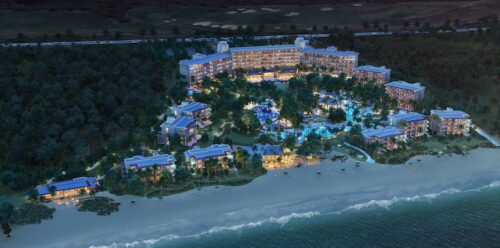
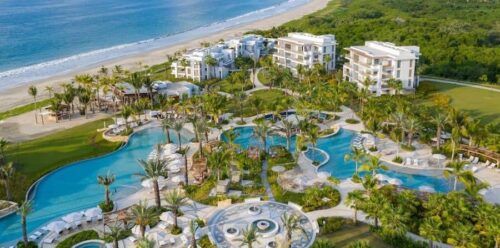
Cloward H2O provided its design expertise for all the pool amenities at the new hotel, which is the first Conrad-branded resort in Mexico. Located on a two-mile-long beachfront, the hotel has 324 rooms spread over 7 floors, each with a beachfront view.
It is also home to an 18-hole golf course, as well as spa facilities and both adult and family pools. Cloward provided engineering design, including electrical & mechanical systems, structural design, water treatment systems and filtration, for the family, activity and adult pools, the family and adult hot tubs, the plaza fountain, the lobby water features, the spa pool and hot tub, and the spa cold plunge pool.
The company worked alongside EDSA and SB Architects to develop the construction documentation for the pools, hot tubs and water features at the resort. This is a renovation of an existing property that the team brought a fresh look to, creating a walkable resort with a beachfront view, tying in the planting, pools and the ocean. The project also included a total redesign of the pool amenities.
The adult pool boasts a swim-up bar and a separate hot tub, while younger guests can have fun in the activity pool and the family pool and hot tub. There is also a children’s splash pad. Those wanting to relax can head to the 10,000 square foot indoor/outdoor Conrad Spa, which is home to a spa pool, hot tub, and cold plunge. Water features in the lobby deck and plaza continue the ocean theme.
Cloward H2O celebrates success of Beijing Aquarium more than 20 years on - 17th Nov 2020
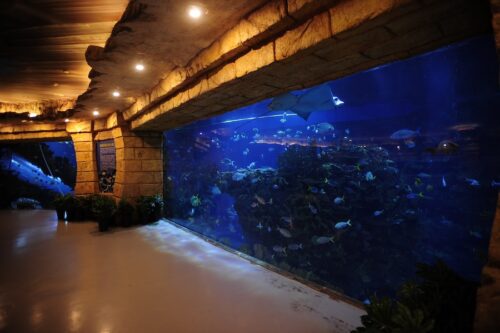

Cloward H2O was commissioned by General Oceanic Environmental Engineering [GOE] to provide engineering and aquatic design for exhibit tanks and life support systems at the Beijing Aquarium in 1994. At the time, this was the largest inland aquarium of its time with several unique aspects.
For instance, due to the cool local climate, the entire aquarium is indoors. Plus, the inland location meant that transporting in saltwater was a challenge. To solve this, Cloward H2O helped to design a system that created artificial, manmade, saltwater for the whole aquarium.
Visitors to the Beijing Aquarium can enjoy tropical forests, a touchable pond, an undersea loop and more. In the tropical forest exhibit, they can walk through a stunning Amazonian forest while looking at 22 fish tanks along the way. Meanwhile, the 52-yard-long coastline of the touchable pond is home to mollusks, sea turtles, sea urchins, starfish, sea anemones and hermit crabs.
The undersea loop allows guests to walk underwater, exploring six oceans through a large plastic tube covering 32 large aquarium exhibits. Despite the fact that The Beijing Aquarium was built more than 20 years ago it is still a huge tourist attraction, pulling in thousands of new visitors each year.
As it celebrates its 45th anniversary this year, Cloward H2O is proud that this iconic aquarium operates like it was brand new, despite being more than 20 years old, and looks forward to seeing it thrive for years to come. The company would like to recognize and thank the owners of the Beijing Aquarium and the employees for the opportunity to have worked on this project and for keeping the Aquarium going strong.
Cloward H2O celebrates 45 years in the business - 17th Sep 2020

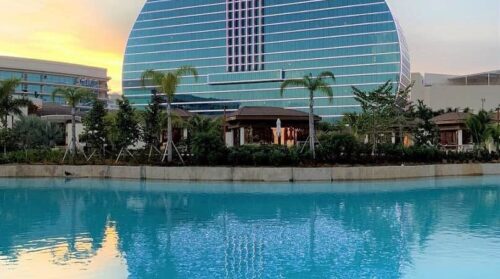
Cloward H2O celebrates its 45th anniversary this year. Over the past 45 years, the company has designed and engineered water quality management systems for prestigious and legendary resorts, aquariums, and waterparks around the world.
Cloward H2O has continuously improved over the past 45 years, winning numerous awards, and developing its knowledge and expertise base. It now has 15+ engineers, designers and drafters and focuses on recreational water projects.
The company specializes in water quality management systems for fountains, swimming pools, spas, activity & surf lagoons, white water rivers, aquariums and any other challenge that involves recreational water.
Most recently, Cloward H2O worked on the expansion of the Seminole Hard Rock Hotel and Casino in Hollywood. The Guitar Tower opened in October 2019 and proved extremely popular with guests.
Cloward H2O helped to develop the 13.5-acre pool amenity area at the Guitar Tower. This included a 2.3-acre recreation lake, where visitors can enjoy water sports such as kayaking and paddle boarding. In addition, the company worked on the indoor facilities at the expansion, which include a central spa pool as well as hot and cold plunge pools. Cloward H2O also provided pools and spas for the two penthouse suites in the Guitar Tower.
The company has worked with numerous luxury resorts, such as the Zulal Wellness Resort. This water-themed resort in Qatar is currently under construction. Cloward H2O is the lead water designer on the 3-million-gallon saltwater lagoon, water fountains and over 60 private suite pools.
In the past 45 years, Cloward H2O has worked on numerous zoo and aquarium projects. At the Turtle Back Zoo, the company worked on an indoor penguin facility that features nesting burrows in the rock walls.
At the historic Manhattan Beach Aquarium, the company helped redesign and engineer the entire interior of the aquarium. The site now includes 14 oceanic tanks, two freshwater tanks and a children’s touch tank.
Cloward H2O won a ULI Impact Award for its sustainable Cloudscape solution in 2018. The company engineered the Cloudscape system in the One Eleven Congress Plaza in Austin, Texas. This innovative system creates cooling clouds to provide a pleasant ambient environment for everyone who visits the plaza. The system is designed to operate effectively in a drought area by using AC condensate.
The founder of Cloward H2O, Greg Cloward, was also inducted into the World Waterpark Association’s Hall of Fame in 2018 to recognize his distinguished career.
The company also won two Aquatics International Dream Design awards in 2018 for its Ouray Hot Springs Swimming Pool in Colorado, and for the Grand Caymans’ Kimpton Seafire Resort and Spa.
Cloward H2O delivers aquatics for luxury resort in Baja California Sur, Mexico - 21st Dec 2018
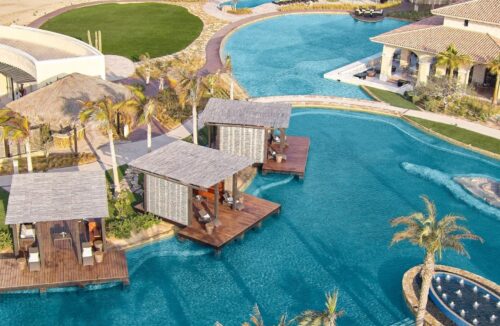
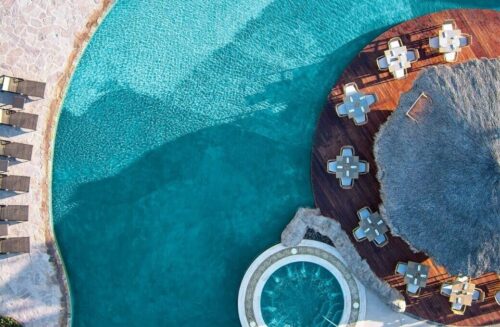
The Grand Solmar at Rancho at San Lucas and The Grand Solmar The Residences covers 834 acres. 89 ocean-front suites are among the hotel and residential properties. The resort, part of the Solmar Collection, is on the southern tip of the Baja peninsula in Mexico’s Baja California Sur.
Cloward H2O worked on a variety of aquatic amenities at the resort. These included the engineering and design of the 0.96 million-gallon saltwater lagoon. The lagoon is fed by water pumped from wells on the beach. It also functions as a water source for the resort’s desalination operation supplying portable water to the resort.
The company delivered two 90,000 gallon infinity pools, with bar and submerged table seating. In addition, a lounge shelf allows guests to relax in the pool and scenic beach dune.
Cloward H2O also completed five jacuzzi spas and a children’s pool with interactive spray toys. In addition they added two water slides and a rooftop pool for a wide range of aquatic amenities at the resort.
The project was in collaboration with HKS Architects and TBG Partners.
Cloward H2O provides aquatics engineering and design expertise across a range of attractions and mixed use facilities. Their latest work includes an exhibit for penguins and flamingos at Essex County Turtle Back Zoo and the historic hot springs pool in Ouray, Colorado.
2018 has been a busy year for the company, with over 182 new projects started. Below are a summary of Cloward H2O’s year in Numbers:
completed projects in 21 U.S. states and 14 countries.
6 new staff members.
1 new fully developed MEP Department, servicing AEC projects locally and Aquatics projects worldwide.
488,000 airline miles flown.
10 trade shows/conferences attended.
Of the 132 completed projects in 2018, these included:
70 Commercial/Resort Pools
18 Single-/Multi-Family Residential Pools
14 Spas
6 Rivers
4 Waterparks
3 Themeparks
17 Fountains
7 Splash Pads
47 Aquarium/Zoo Exhibits
18 Hot Springs Pools
2 Large Swimming/Snorkel Lagoons
1 Wakeboarding Lake
1 Whitewater Rafting Facility
and 1 system for heating popcorn oil
Cloward H2O celebrates ULI Impact Award for sustainable Cloudscape solution - 4th Sep 2018
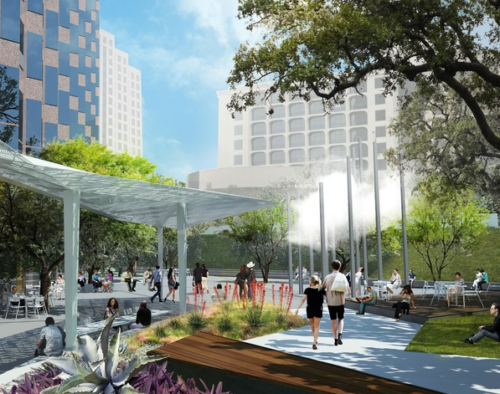
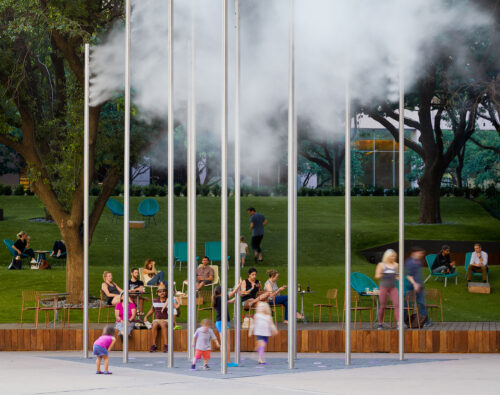
A sustainable area-cooling solution, Cloudscape, by Cloward H2O and dwg. architects has won an Urban Land Institute (ULI Austin) Impact Award for Project Innovation.
ULI Austin members are committed to responsible development and sustainable land use with the aim of building better communities. The category recognizes originality and creativity in development.
Cloudscape is an iconic feature of the newly-developed Fareground at One Eleven Congress Plaza in Austin, Texas. The system creates cooling clouds to provide a pleasant ambient environment for the many professionals, residents and visitors who flock to the vibrant community hub.
To realize their vision, dwg. architects turned to leading provider of aquatic design engineering services, Cloward H2O. The brief was to create a system that could still operate effectively in a drought.
Designed to be self-sustaining, the system doesn’t draw on the city’s valuable water reserves. Instead, it utilizes previously wasted water from the building’s own air conditioning condensate. This amounts to a staggering 280,000 gallons a year.
What is particularly clever about this unique method of water recycling is that it provides more water during hot summer months when demand is high, than during the winter. The harvested condensate is collected, treated, stored, and then atomized at high pressure from tall, elegant pylons.
Founded in 1977, Cloward H2O works with landscape architects and other partner organizations to design and engineer waterparks, theme parks, splash pads, pools, spas, fountains, marine exhibits, life support systems and more.
Two Cloward H2O projects honored with Aquatics International Dream Design awards - 10th Aug 2018

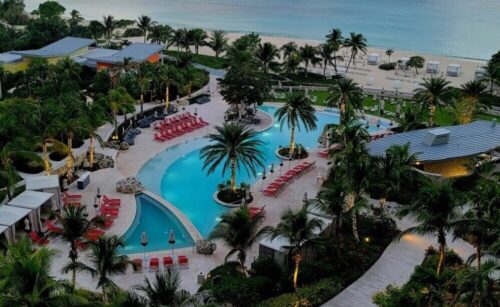
Cloward H2O celebrates as two of it’s projects have been awarded Aquatics International Dream Design Awards 2018.
The awards recognise the best projects in the aquatics industry from competition pools to family aquatics centres to full-scale waterparks.
Ouray Hot Springs Swimming Pool is the first Dream Design winner. The historic hot springs pool in scenic Ouray, Colorado, was completed re-engineered by Cloward H2O and city operations staff. Capacity at the pools was doubled by creating 5 independently operated pools within the boundaries of the original oval shape. The design carefully made use of the available geothermal water and didn’t distract from the mountainous backdrop.
Also honored the Grand Caymans’ Kimpton Seafire Resort and Spa. For the project, Cloward H2O designed a main area with three terraced pools, a plunge pool and a shallower children’s play pool with beach entry and interactive elements. Cloward also designed a quieter Oasis Pool and indoor health spa for adults which includes a hydrotherapy pool with infinity edges. The entire resort was developed as a contemporary view of the Caribbean using local materials, taking inspiration from the environment.


